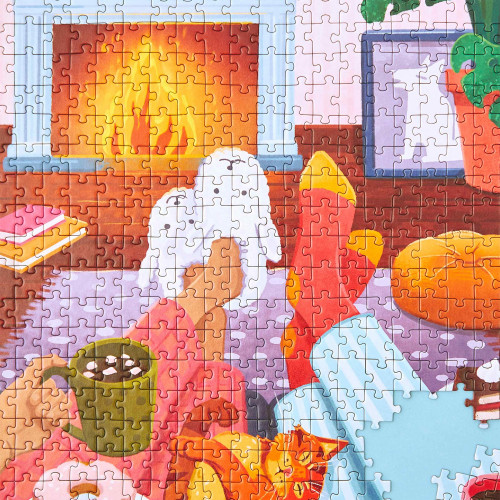From €59 purchase: -10% and 1 free imitation game with the code NOEL25 🎁
To enjoy your gifts under the tree 🎄: we recommend ordering before 12/18 (France) and 12/17 (other countries)
First order? 1 free maracas dumbbell Confetti with the code BIENVENUE-JANOD
From €150 purchase: 1 free mini xylophone with the code CONFETTI25 ✨
Free delivery for purchases over €40
Free shipping from €40 of purchase 🎁
Vous devez avoir un compte pour pouvoir utiliser cette fonctionnalité.
Connexion InscriptionPlayback time: 30 min
For generations, jigsaw pu zzles have been the ultimate learning pastime. Piece by piece, famous paintings and landscapes come to life under our fingers. Beneficial for the memory and logic of the whole family, jigsaw puzzles today come in a multitude of themes! It's hard to choose a puzzle for yourself, your baby or your older child: it's a question of finding the right number of pieces and the most attractive illustrations, to make this moment of play a moment of relaxation and pleasure.
From wooden baby puzzles to 2000-piece jigsaw puzzles, there's a Janod puzzle for everyone: follow our guide to choosing the right one!
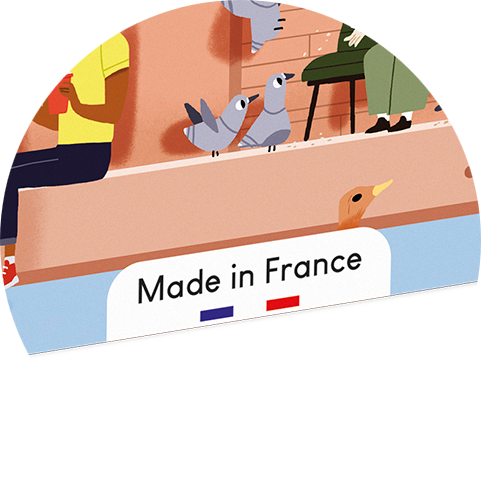
Sturdy, with pieces that are easy for little ones to grasp, the wooden puzzle is ideal for babies from 18 months. Each piece is an element in its own right, so each character finds its own place on the support: children begin to test the positions to fit the elements in the right places, developing their fine motor skills and logical thinking.
A 2-year-old's puzzle can also be the basis for a whole new range of adventures! On the farm, in the forest or with the dinos, little ones' imaginations bring the elements to life. Baby's wooden puzzle takes on a whole new dimension, thanks to large, easy-to-handle pieces that can leave the tray and become real figurines.
Puzzle pieces are adapted to baby's needs in terms of both size and number. Indeed, you'll find plenty of 6-piece puzzles in our selection.
Janod's wooden puzzles invite children to discover animals, the alphabet and shapes: well thought-out for developing baby's vocabulary! Whether he prefers a dinosaur puzzle or a cat puzzle, you can be sure that your little one will be stimulated by a fun activity.
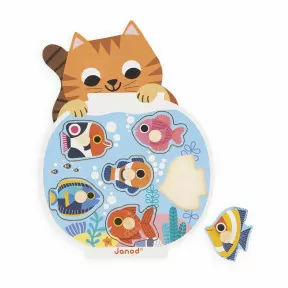
Aquarium Puzzle
Beware, a naughty feline is very interested in life in this beautiful aquarium! And your little ones will certainly be just as interested as he is! For babies from 18 months old who are starting to grasp and have increasingly refined gestures, this wooden peg puzzle is perfect! Our darling toddlers will have to use their logic so that the 6 tropical fish can find their place before the cat grabs them. They have beautiful colours and shapes, which will delight little ones, who love the inhabitants of the seabed. The wooden pegs on each piece make them easier for children to grasp, which allows them to work on fine motor skills. After a few tries, little ones will enjoy finding the right match and starting over to recreate the pretty scene. This early years puzzle measures 20.5 x 27.9 cm.
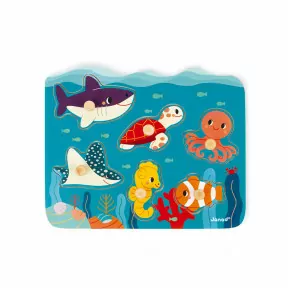
Marine Animals Wooden Pin Puzzle - In partnership with WWF®
This early-years puzzle brings together the world’s most impressive marine mammals to delight little ones - and spark their curiosity! This wooden puzzle for babies aged 18 months and over allows your child to dive into the underwater universe at the same time as developing their logic and fine motor skills! There are 6 animal pieces to position correctly on the board. Baby can move them easily using the wooden pins, which are specially designed for little hands. Made of FSC®-certified wood from sustainably managed forests. Water-based paint. Did you know? Oceans and seas cover 70% of our planet, and provide 97% of the water on Earth! They provide food and oxygen as well as regulating our climate. Toy developed in collaboration with WWF®. Janod is supporting WWF®™’s efforts to protect the environment and biodiversity with a new range of toys made from more sustainable materials. We hope this range will inspire the next generation and encourage them to stand up for wildlife and the natural world in the future.
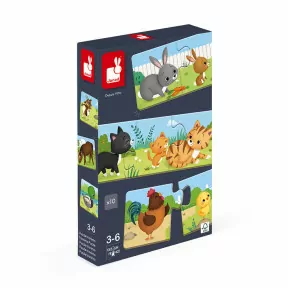
Trionimo 30-Piece Puzzle Matching Game
The baby animals have lost their father and mother. Help to reunite them! This association game is ideally suited to developing children’s fine motor skills. It will help them to explore and to become familiar with the world of animals and their family (eg. the chick with the rooster and the hen). A piece can only have one good position. Dims : 21 x 7,5 cm, thickness 3 mm. An association game in cardboard about farm animals, composed of 30 pieces. This product is made of FSC® -certified and other controlled material.
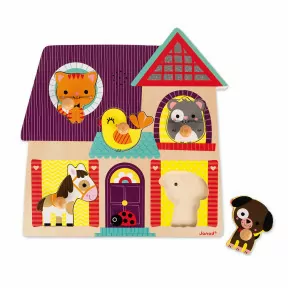
Musical Puzzle My Little Friends 5 pieces (wood)
Adding a sound dimension to toddler puzzles to promote even more discoveries! This is exactly what this early-learning pets-themed wooden puzzle has to offer! Besides learning the names of the animals, babies can also have fun putting the right piece in the correct space on this 5-piece wooden puzzle If placed correctly, the cry of the animal piece in question will sound! Dogs, birds, hamsters, cats and horses will no longer be strangers to children! The wooden pegs make the pieces easier to grasp. This toy - suitable for children aged 18 months and up - is ideal for developing patience and fine motor skills.
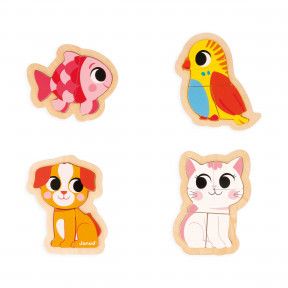
4 Progressive Puzzles - Pet
From the age of 18 months, children can begin to learn about the joys of puzzles! Perfect for developing fine motor skills and coordination! This set of 4 early-learning progressive puzzles will delight little pet lovers! With this wooden puzzle set - presented in a pretty gift box - which contains 4 puzzles, ranging from 2 to 5 pieces, children can have fun whilst progressing at their own pace. Featuring little ones’ favourite animals: a 2-piece fish, a 3-piece dog, a 4-piece parrot and a 5-piece cat. The pieces - which must be put back in the right order on the wooden stand - have been designed for babies to grasp onto them well. This early-learning game will be a true pleasure to play! This toy can also be used to prompt children to learn their first numbers. The puzzles are made from FSC® wood.
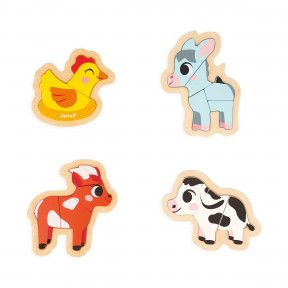
4 Progressive Puzzles - Farm
From the age of 18 months, children can begin to learn about the joys of puzzles! Perfect for developing fine motor skills and coordination! This set of 4 early-learning progressive puzzles will delight little farm animal lovers! With this wooden puzzle set - presented in a pretty gift box - which contains 4 puzzles, ranging from 2 to 5 pieces, children can have fun whilst progressing at their own pace. Featuring little ones’ favourite animals: a 2-piece hen, a 3-piece cow, a 4-piece goat and a 5-piece donkey. The pieces - which must be put back in the right order on the wooden stand - have been designed for babies to grasp onto them well. This early-learning game will be a true pleasure to play! This toy can also be used to prompt children to learn their first numbers. The puzzles are made from FSC® wood.
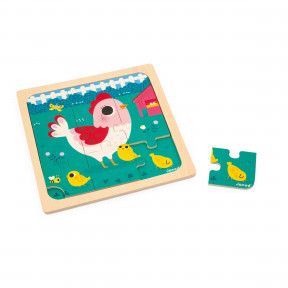
Henriette The Chicken Puzzle
Henriette the hen cannot wait to introduce little ones to their very first puzzles! Wooden puzzles serve as great gifts for babies aged 18 months and up: they are a great source of learning and satisfaction, so what are you waiting for? Children will love the pretty scene depicted on this early-years puzzle model: a hen and her 3 little chicks at the farm. It consists of 9 wooden pieces, plus a recess so that the pieces can easily be removed. The printed model found under the puzzle will help first-timers get to grips with the concept. Everything is on a wooden stand; therefore, this early-learning game is easy to store and transport. This puzzle is ideal for helping your child develop fine motor skills, concentration and independence. Made from FSC® wood.
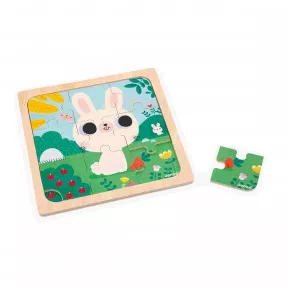
White Rabbit Puzzle
The white bunny cannot wait to introduce little ones to their very first puzzles! Wooden puzzles serve as great gifts for babies aged 18 months and up: they are a great source of learning and satisfaction, so what are you waiting for? Children will love the pretty scene depicted on this early-years puzzle model: an adorable, hungry rabbit in the middle of a nature scene. It consists of 9 wooden pieces and a recess so that the pieces can easily be removed. The printed model found under the puzzle will help first-timers get to grips with the concept. Everything is on a wooden stand; therefore, this early-learning game is easy to store and transport. This puzzle is ideal for helping your child develop fine motor skills, concentration and independence. Made from FSC® wood.
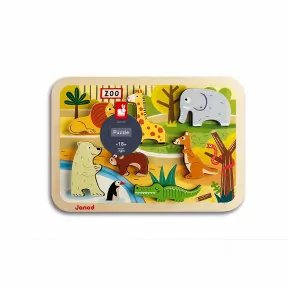
Chunky Puzzle Zoo 7 pieces (wood)
Wooden puzzle on the topic of the Zoo. 7 animals in 3D, thickness of 1,5 cm. Discover the exciting world of zoo animals! Your child will have fun putting the animals in the right place and playing with the pieces that stand up just like real figures. Your child will have fun as he or she develops his or her motor skills and imagination.
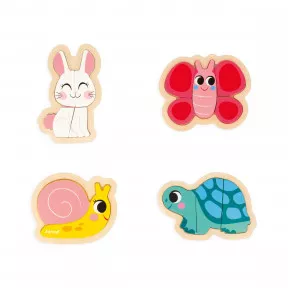
4 Progressive Puzzles - Garden
From the age of 18 months, children can begin to learn about the joys of puzzles! Perfect for developing fine motor skills and coordination! This set of 4 early-learning progressive puzzles will delight little ones who love nature and the creatures living in their garden! With this wooden puzzle set - presented in a pretty gift box - which contains 4 puzzles, ranging from 2 to 5 pieces, children can have fun whilst progressing at their own pace. Featuring little ones’ favourite animals: a 2-piece snail, a 3-piece tortoise, a 4-piece rabbit and a 5-piece butterfly. The pieces - which must be put back in the right order on the wooden stand - have been designed for babies to grasp onto them well. This early-learning game will be a true pleasure to play! This toy can also be used to prompt children to learn their first numbers. The puzzles are made from FSC® wood.
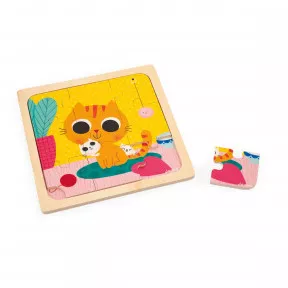
Peanut The Cat Puzzle
Peanut the cat cannot wait to introduce little ones to their very first puzzles! Wooden puzzles serve as great gifts for babies aged 18 months and up: they are a great source of learning and satisfaction, so what are you waiting for? Children will love the pretty scene depicted on this early-years puzzle model: an adorable tomcat and his 2 playful kittens. It consists of 9 wooden pieces, plus a recess so that the pieces can easily be removed. The printed model found under the puzzle will help first-timers get to grips with the concept. Everything is on a wooden stand; therefore, this early-learning game is easy to store and transport. This puzzle is ideal for helping your child develop fine motor skills, concentration and independence. Made from FSC® wood.
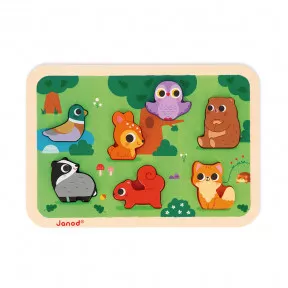
Chunky Forest Puzzle 7 pieces
Knock, knock, Mr Squirrel? Discover our forest animal-themed wooden puzzle, designed for babies aged 18 months and up. This early-learning comprises 7 thick pieces that can easily be grasped by little hands. Each piece of the puzzle has been specifically designed to represent a forest-dwelling animal: fox, squirrel, badger, deer, owl, bear and duck. And that's not all! These pieces can also be used as figurines to extend playtime and stimulate your child's imagination. This wooden puzzle is more than just an early-years toy, it’s an educational tool that will help develop your baby's fine motor skills. By manipulating and assembling the puzzle, your child will improve their coordination and concentration. This early-learning toy is ideal as a first approach to learning the names of woodland animals that baby is sure to encounter in stories and as they explore. By playing with the pieces and slotting them into the board, your child will develop their gripping skills. A wooden puzzle is also a great way to stimulate logical thinking! Give this adorable puzzle to baby at mealtimes to keep them occupied, or as a calm post-nap activity. Which forest animal will become their favourite? FSC™ wood puzzle with water-based paint.
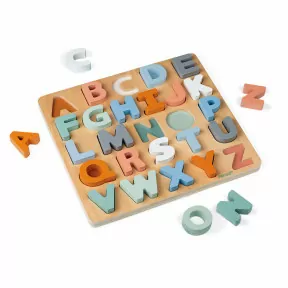
Sweet Cocoon Alphabet Puzzle
It's time to get to grips with the alphabet! Introducing a toy that will amuse your child whilst prompting them to discover the letters of the alphabet! This wooden early-learning toy - suitable for children aged 2 years and up - boasts soft pastel colours and will help your child learn the alphabet at their own pace, thanks to several levels of play. These include placing the letters on the corresponding colours, identifying the letters and then writing them on the opposite side - the blackboard - with the chalk provided. This wooden toy is part of the Sweet Cocoon collection; a delicate-coloured range inspired by the current trends to sweetly promote your child's early-learning experiences! This game comprises 26 wooden letters, 1 piece of chalk and a double-sided wooden board.
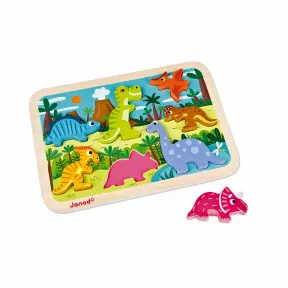
Chunky Puzzle Dinosaurs 7 pieces (wood)
Wooden puzzle on the topic of the dinosaurs. 7 pieces in 3D, thickness of 1,5 cm. Discover the fascinating world of dinosaurs! Your child will have fun putting the animals in the right place and playing with the pieces that stand up just like real figures. Your child will have fun as he or she develops his or her motor skills and imagination.
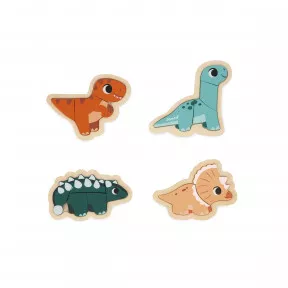
Dino - 4 Progressive Puzzles Dino
Calling all little dinosaur fans! 4 beautiful figurines are all set to entertain little ones, whilst also making them think! Look at these 4 ultra-cute progressive wooden puzzles for babies aged 18 months and up! Start off with the 2-piece puzzle and then gradually increase the difficulty, up to the 5-piece model. Let's bring the 2-piece Triceratops, 3-piece T-Rex, 4-piece Diplodocus, and 5-piece Ankylosaurus back to life. To make this early-years game even easier, the wooden puzzle pieces nestle into 4 bases. This early-learning puzzle is ideal for developing little ones’ dexterity. Made from FSC® wood.

4 Progressive Puzzles - Farm
From the age of 18 months, children can begin to learn about the joys of puzzles! Perfect for developing fine motor skills and coordination! This set of 4 early-learning progressive puzzles will delight little farm animal lovers! With this wooden puzzle set - presented in a pretty gift box - which contains 4 puzzles, ranging from 2 to 5 pieces, children can have fun whilst progressing at their own pace. Featuring little ones’ favourite animals: a 2-piece hen, a 3-piece cow, a 4-piece goat and a 5-piece donkey. The pieces - which must be put back in the right order on the wooden stand - have been designed for babies to grasp onto them well. This early-learning game will be a true pleasure to play! This toy can also be used to prompt children to learn their first numbers. The puzzles are made from FSC® wood.

4 Progressive Puzzles - Pet
From the age of 18 months, children can begin to learn about the joys of puzzles! Perfect for developing fine motor skills and coordination! This set of 4 early-learning progressive puzzles will delight little pet lovers! With this wooden puzzle set - presented in a pretty gift box - which contains 4 puzzles, ranging from 2 to 5 pieces, children can have fun whilst progressing at their own pace. Featuring little ones’ favourite animals: a 2-piece fish, a 3-piece dog, a 4-piece parrot and a 5-piece cat. The pieces - which must be put back in the right order on the wooden stand - have been designed for babies to grasp onto them well. This early-learning game will be a true pleasure to play! This toy can also be used to prompt children to learn their first numbers. The puzzles are made from FSC® wood.

4 Progressive Puzzles - Garden
From the age of 18 months, children can begin to learn about the joys of puzzles! Perfect for developing fine motor skills and coordination! This set of 4 early-learning progressive puzzles will delight little ones who love nature and the creatures living in their garden! With this wooden puzzle set - presented in a pretty gift box - which contains 4 puzzles, ranging from 2 to 5 pieces, children can have fun whilst progressing at their own pace. Featuring little ones’ favourite animals: a 2-piece snail, a 3-piece tortoise, a 4-piece rabbit and a 5-piece butterfly. The pieces - which must be put back in the right order on the wooden stand - have been designed for babies to grasp onto them well. This early-learning game will be a true pleasure to play! This toy can also be used to prompt children to learn their first numbers. The puzzles are made from FSC® wood.
If you're looking for a 4-piece puzzle, or if you want to offer your child a game that adapts to his or her progress, you can also choose an evolving puzzle. We offer sets of 4 wooden evolutionary puzzles, where each puzzle has a different number of pieces, from 2 to 5.
A wooden toy is a guarantee of durability, and when the complexity of the puzzle follows the child's progress, it's even more durable!
Their first puzzles, just like the grown-ups! In the kingdom of the princesses, in the heart of the action with the firemen or on the ice floe, puzzles for 3-year-olds promise a multitude of surprises.
With their 20-piece jigsaw puzzle, children refine their ability to assemble the elements according to the model. They also enrich their vocabulary thanks to the soft, varied illustrations, suitable for the youngest. The surprise puzzle is ideal for a first introduction to cardboard puzzles: pull the tabs to discover hidden elements or amusing illustrations, and the animal puzzle comes to life! The tactile puzzle, meanwhile, offers a variety of materials to discover with your fingertips. Once the pieces have been assembled, the child can explore the scenery in search of different textures: it's time to awaken the senses!
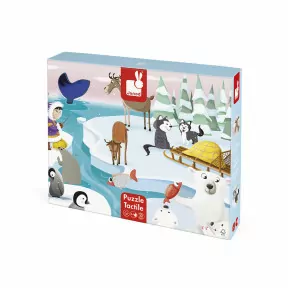
Tactile Puzzle Life On the Ice 20 pieces
Giant 20-piece puzzle in rigid cardboard, with 7 pieces with textures (fur for the white bear, penguin, deer, husky dog, fake sealkin, metal effect for the whale tale, glitters effect for fish). Illustration with soft colors on the Life on the Ice floe theme. Poster included. This product is made of FSC® -certified and other controlled material. This product is made of FSC® -certified and other controlled material.
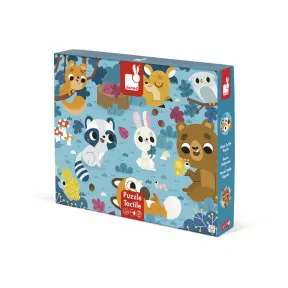
Tactile Puzzle Forest Animals 20 pieces
Children aged 2 years and up will love this giant forest animal-themed tactile puzzle! Once this beautiful 20-piece puzzle has been completed, they will be able to discover the different textures and materials found around the puzzle and thus, develop their touch perception and observation skills. The pieces have been designed to be grasped in little hands and a model poster is also included. This puzzle comprises 20 pieces, including 7 textured pieces, so little ones can explore both their senses and the forest-dwelling animals!
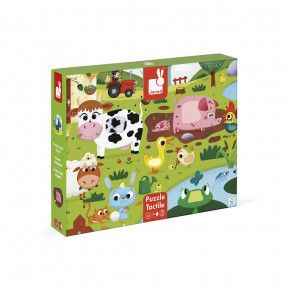
Tactile Puzzle Farm Animals 20 pieces
Giant 20-piece puzzle in rigid cardboard, with 7 pieces with textures (fur for the cow, sheep, imitation of the rabbit tail, pig, duck, rooster's crest, frog). Illustration with bright colors on the farm animals theme. Poster included. Puzzle : 65 x 50 cm (25.6 x 19.7 in). This product is made of FSC® -certified and other controlled material.
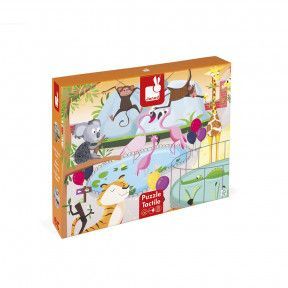
Tactile Puzzle A Day At the Zoo 20 pieces
Let's look at the zoo animals on this 20-piece puzzle suitable for children aged 2 years and up! What’s more... it is tactile! Discovering the tiger’s soft coat or the crocodile’s rough skin will be such a joy when the puzzle is completed! Little ones can caress and discover these fun materials to help develop their sense of touch! The beautiful illustrations on this vibrantly-coloured giant puzzle will immerse you in a world full of fun details. A poster, which serves as a model, is supplied with this puzzle to promote instant independent play. This puzzle measures 65 x 50 cm when complete and boasts 7 textured pieces.
Presented in an attractive carrying case with handle, the 24-piece puzzle invites children into ever more animated scenes: characters, vehicles and animals are always busy! New challenges for 3- to 4-year-olds. How about a magic puzzle? Once the puzzle is done, use the included lamp to discover hidden elements!
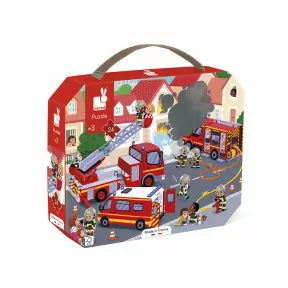
Puzzle Firemen - 24 pieces
Join the firefighters in the middle of a callout! Here is a pretty 24-piece cardboard puzzle on the theme of firefighters, ideal for children from 3 years old. Bringing the fire under control, treating the injured and making the surrounding area safe: it's a day full of adventure that awaits our little firefighters! This richly illustrated puzzle will help your child develop their memory and dexterity, whilst having fun. The 24 pieces are suitable for small hands, for easy handling by children. They can use the template poster provided to put the puzzle together at their own pace. This puzzles comes in a beautiful case with handle and is easy to store and transport. This puzzle is made in France using mix FSC™ cardboard and vegetable-based inks.
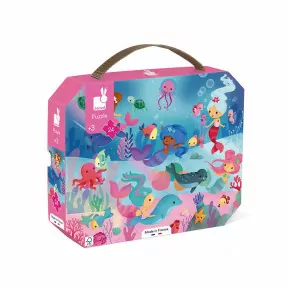
Puzzle Mermaids 24 pieces
24-piece cardboard puzzle on the theme of mermaids. Poster included to make it easier to complete the puzzle. Puzzle: 50 x 40 cm. The forest-based material in this product is recycled. Made in France. Mix FSC®.
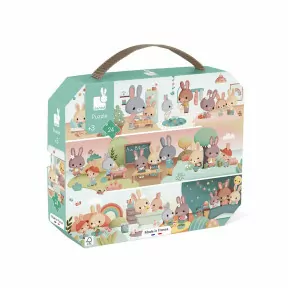
Puzzle A Day - 24 pieces
Follow the day-to-day adventures of this adorable family of rabbits! This pretty 24-piece cardboard puzzle will help your child to find his bearings in time and identify the small rituals of daily life: getting up, getting dressed, then going to school and up until bedtime. A very good medium for learning, sharing and developing the motor skills of young children. Presented in a case with a handle, this puzzle is easy to store and transport. It comes with a poster that serves as a template for putting the puzzle together at your own pace. This soft-coloured puzzle is ideal for children from 3 years old, with its 24 pieces suitable for little hands. It is a puzzle made in France and decorated with vegetable inks. The forest-based material in this product is recycled.
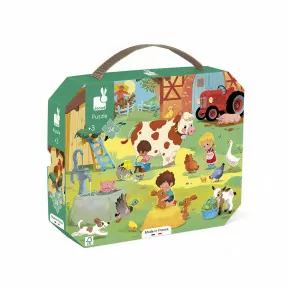
Puzzle A Day At The Farm - 24 pieces
Ready for a trip to the farm? A tractor, a host of animals and a lot of funny details await your child for an entertaining and fun activity! Find the farm animals in this 24-piece cardboard puzzle. The pieces are suitable for the hands of children from 3 years old, for easy handling! What is this animal ? What are the little rabbits doing? A fun way to develop young children's memory and dexterity. This lively puzzle comes with a poster as a template, so you can put the puzzle together at your own pace! Comes in a pretty case with handle, for easy storage of the pieces and transport. This delightful puzzle is made in France. The forest-based material in this product is recycled. Decorated with vegetable inks, this puzzle promises long hours of fun!
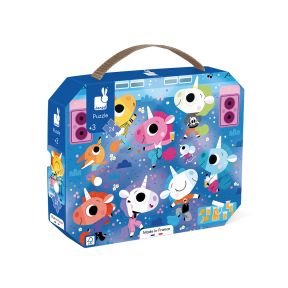
Puzzle Rock Concert Unicorns 24 pieces
It’s time to nod your head to the rhythm! This 24-piece puzzle invites its audience to a fabulous unicorn rock group concert! Children aged 3 years and up will be raring to immerse themselves in a musical yet magical universe. This puzzle comes with a poster to help little ones put the pieces in the right place. Each piece of the puzzle reveals a little bit more of this electrifying event, headed by the rocking unicorns, thus developing toddlers' fine motor skills and imagination: a rock 'n' roll challenge for little hands! Imagine your child's joyful expression when they put the pieces together to reveal a wild concert scene brought about by beautiful, bustling creatures. This unicorn puzzle comes in a colourful case with a handle, so your child can take it wherever they like. They can sit wherever they want to calmly assemble this puzzle, and then have fun watching the animals party! Are you ready to embark on a fantastic and above all rock 'n' roll adventure? This puzzle is made in France, decorated with vegetable inks and made from FSC™ cardboard.
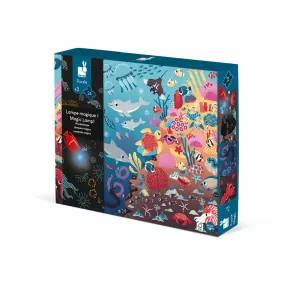
Ocean Magic Puzzle
This is a new kind of puzzle that children are bound to love! What’s so special about it? It’s magic, that’s what! This 24-piece puzzle will help children aged 3 and over to discover the seabed, thanks to its special lamp that reveals all sorts of hidden details! Are you ready to explore the depths? In that case, you should start by completing this delicately coloured jigsaw. Then switch on the little magic lamp to sneak a look at octopuses, sea anemones and jellyfish going about their nocturnal business! The hidden elements will suddenly appear in blues and yellows! The pieces are large enough for even the smallest toddlers to grab hold of. This incredible 2-in-1 puzzle will spark children’s curiosity as they try to discover more about the little ocean-dwellers picked out by the light! A poster is included to help younger toddlers. This product is made of FSC® -certified and other controlled material.
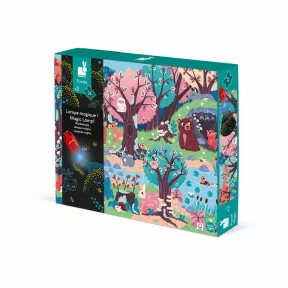
Magic Forest Puzzle
This is a new kind of puzzle that children are bound to love! What’s so special about it? It’s magic, that’s what! This 24-piece puzzle will help children aged 3 and over to discover nocturnal animals, thanks to its special lamp that reveals all sorts of hidden details! Are you ready to explore the secrets of the forest in the middle of the night? In that case, you should start by completing this delicately coloured jigsaw. Then switch on the little magic lamp to sneak a look at owls, squirrels and hedgehogs going about their nocturnal business! The hidden elements will suddenly appear in whites and yellows! The pieces are large enough for even the smallest toddlers to grab hold of. This incredible 2-in-1 puzzle will spark children’s curiosity as they try to discover more about the little forest-dwellers picked out by the light! A poster is included to help younger toddlers. This product is made of FSC® -certified and other controlled material.
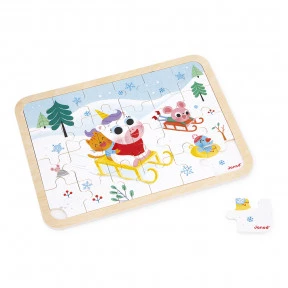
In the mountains 24-piece wooden puzzle
Ready for a sled race? With this 24-piece puzzle, children from the age of 3 can develop their concentration and fine motor skills, as well as their sense of observation. Piece by piece, they assemble a winter setting, where the unicorn meets up with his friends to play in the snow! There's room for two on the yellow sled, while the mouse on the orange sled has fun sliding along... And the little bird? Looks like he's taken the lead! The puzzle template is printed on the bottom of the tray, to help children complete the puzzle. Ideal for learning the names of farm animals and delighting fans of unicorns, this wooden puzzle invites little ones to use their deductive powers. How do you do it? By including a difference game! There are 5 differences on the puzzle illustration: have fun finding them as a family! The clever puzzle features a small notch in one corner for easy removal of the pieces. With this mountain puzzle, your child can have fun and stimulate his brain with a tried-and-tested calm activity! In its 30 x 22 cm format, it's made from FSC™-certified wood from sustainably managed forests. Faster, faster!
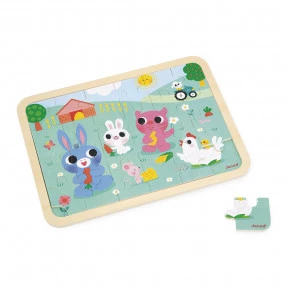
Wooden puzzle At the farm 24 pieces
Visit the farm animals! With this 24-piece puzzle, children from the age of 3 can develop their concentration and fine motor skills, as well as their sense of observation. Piece by piece, they assemble a rural setting, where the animals come together for a snack! The donkey shares his carrots with the rabbit, the mouse eats cheese... And the sheep over there? Always late, that one! The puzzle template is printed on the bottom of the tray, to help children complete the puzzle. Ideal for learning the names of farm animals and their favorite foods, this wooden puzzle invites little ones to use their deductive powers. How do you do it? By including a difference game! There are 5 differences on the illustration of the puzzle: have fun finding them as a family! The clever puzzle features a small notch in one corner for easy removal of the pieces. With this animal puzzle, your child will have fun and stimulate his brain with a tried-and-tested calm activity! In its 30 x 22 cm format, it's made from FSC™-certified wood from sustainably managed forests. Yummy!
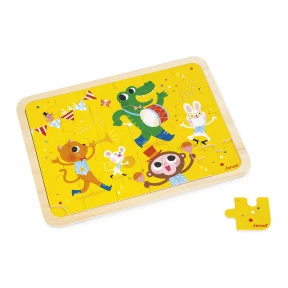
It's party time 24-piece wooden puzzle
The animals are having a party! With this 24-piece puzzle, children from the age of 3 can develop their concentration and fine motor skills, as well as their sense of observation. Piece by piece, they assemble a festive décor, where the animal fanfare beats time! A trumpet-playing cat, a crocodile with a drum... And this rabbit? He just sets the mood! The puzzle template is printed on the bottom of the tray, to help children complete the puzzle. Ideal for learning the names of animals and musical instruments, this wooden puzzle invites little ones to use their deductive powers. How do you do it? By including a difference game! There are 5 differences on the puzzle illustration: have fun finding them as a family! The clever puzzle features a small notch in one corner for easy removal of the pieces. With this animal puzzle, your child will have fun and stimulate his brain with a tried-and-tested calm activity! In its 30 x 22 cm format, it's made from FSC™-certified wood from sustainably managed forests. Let's hear some music!
A 36-piece Janod puzzle is an excellent way to keep children aged 4 and over busy with a calm, rewarding activity. Using the model as a starting point, little ones develop their logic and dexterity. Here they are, immersed in fairyland, the hustle and bustle of the city or the construction site! The size of the pieces has been specially designed to match the age and level of difficulty of the puzzlers , making them appealing to young and old alike. A handy little case to store all the pieces!
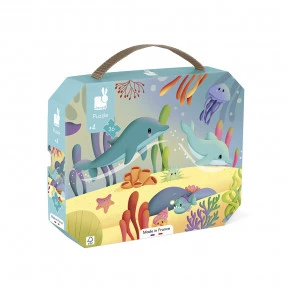
Sea Animals Frieze Puzzle 36 pieces
Discover the depths of the ocean! Dive in search of marine animals with this 36-piece illustrated frieze on the theme of sea creatures, suitable for children aged 4 and over. This 100 x 20 cm panoramic puzzle offers total immersion in the ocean depths. The pieces are perfectly suited to the small hands of 4-year-olds, helping to develop their fine motor skills and logic. This marine puzzle is also ideal for stimulating concentration and patience. The poster supplied can be used as a model to help children assemble the puzzle. The result is an enchanting panorama, as if they were sailing aboard a submarine like sea explorers! They can then use the puzzle as a search-and-find game, challenging themselves to locate and name all the marine animals hidden inside. The whole set comes in an attractive carrying case with handle, making it easy to store and transport. With this puzzle, children and adults can share a moment of calm and serenity: it's an opportunity to stimulate the little ones' imagination. So get on board together! Made in France, this puzzle is produced with vegetable-based inks and FSC™ cardboard.
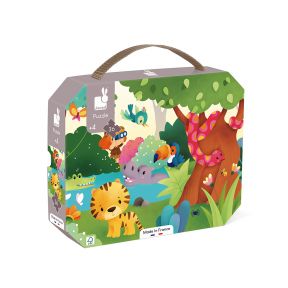
Wild Animals Puzzle 36 pieces
Onward little explorers! Discover the animal world with this wild animal-themed illustrated puzzle, suitable for children aged 4 years and up. This puzzle comprises 36 pieces and comes with a poster that can be used as a model. The dimensions of the completed puzzle will be 100 x 20 cm. Everything is stored inside a pretty suitcase-style box with a handle, which makes it practical for both storage and transport. This panoramic puzzle will fully immerse puzzlers in the world of wild animals! The large pieces are perfectly suited to little hands and help develop children's fine motor skills. This animal puzzle is ideal for stimulating toddlers’ concentration and patience. It also helps children learn the names of wild animals in a fun way. Children and adults will bond whilst attempting to complete this panoramic puzzle. It’s an opportunity to tell stories about wild animals and stimulate little ones’ imaginations! So, are you ready for an adventure? This puzzle is made in France from FSC™ cardboard and illustrated with vegetable inks.
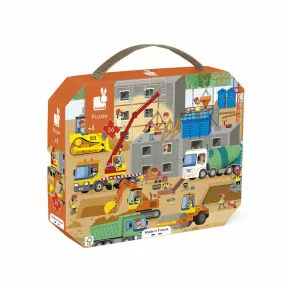
Puzzle Construction Site - 36 pieces
All set for a new day on the building site! Put on your safety gear and join the construction team with this 36-piece cardboard puzzle. With a wealth of illustrations and details, this puzzle will delight young fans of machines. A multitude of professions are represented, which makes it very entertaining. The size of the pieces is suitable for the small hands of children from 4 years old. A poster serving as a template is provided, to put your puzzle together at your own pace. You can store all the pieces and easily transport the puzzle in its pretty case! This brightly coloured puzzle is decorated with vegetable inks. This puzzle is made in France using mix FSC™ cardboard. It's a puzzle made in France that will quickly become your child's favourite toy!
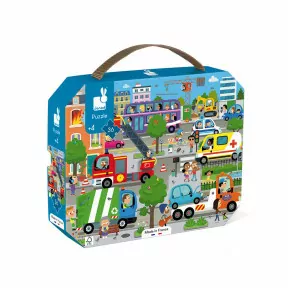
Puzzle City - 36 PCS
With this cardboard puzzle, your child will discover the hustle and bustle of the town while developing his dexterity and concentration. In its pretty little case, this puzzle will be easy to transport thanks to its fabric handle. Contains a poster that serves as a model. Number of pieces: 36. The forest-based material in this product is mix FSC®. Made in France.
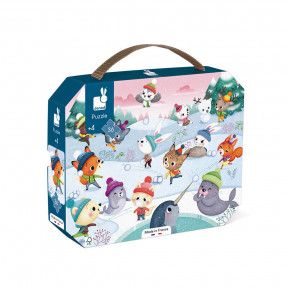
Puzzle Snow Party -36 PCS
Snow has fallen in the forest and the animals leap at the opportunity to have a giant snowball fight! This 36-piece cardboard puzzle - for children aged 4 years and up - is a real feast for the eyes! Soft colours, funny yet kind characters and a winter scene depicting a snowball fight in full swing that will get kids animatedly wanting to join in! Children will enjoy completing this puzzle whilst developing their memory and dexterity skills. This puzzle can easily be carried everywhere, thanks to its awesome fabric-handled suitcase-shaped box. For the first time, it also contains a model poster. After a while, they will then be able to complete the puzzle on their own! The forest-based material in this product is mix FSC®.
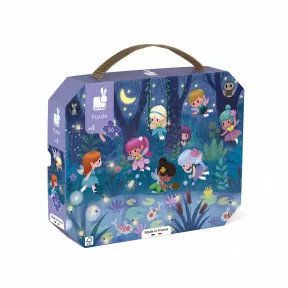
Puzzle Fairies And Waterlilies - 36 PCS
To discover this little fairy world, while developing memory and dexterity, here’s a beautiful 36-piece cardboard puzzle. In its pretty little case, this puzzle will be easy to transport thanks to its fabric handle. Contains a poster that serves as a model for beginners, with the more experienced then able to complete the puzzle on their own. The forest-based material in this product is FSC® mix. Made in France.
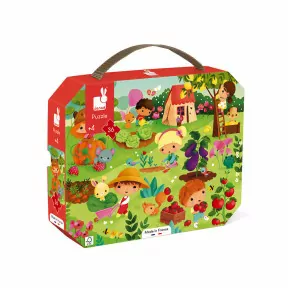
Puzzle Garden - 36 PCS
To discover the garden and admire nature, while developing memory and dexterity, here’s a beautiful 36-piece cardboard puzzle. In its pretty little case, this puzzle will be easy to transport thanks to its fabric handle. Contains a poster that serves as a model for beginners, with the more experienced then able to complete the puzzle on their own. The forest-based material in this product is recycled. Made in France.
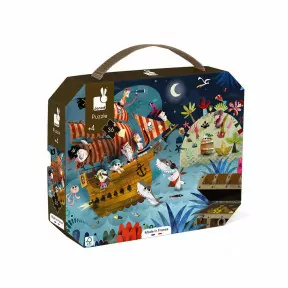
Puzzle Treasure Hunt 36 pieces
A mysterious and nocturnal atmosphere for this puzzle featuring pirates in search of gold and silver! But the mission is tough and the path to the treasure chest is treacherous! Little ones are going to adore these illustrations and want to get started on the puzzles. This is suitable for children between the ages of 4 and 7. It contains a poster to help the child. Number of pieces: 36. The forest-based material in this product is recycled. Made in France.
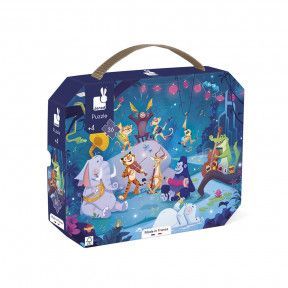
Puzzle Summer Festivities - 36 pieces
Listen carefully, it seems that a party is in full swing in the middle of the jungle! Happy animals have gathered to party to music and bring this 36-piece cardboard puzzle to life. You can almost hear the music as you put the pieces together! A beautiful puzzle for children, which will help them develop memory and dexterity while having fun. And why not name all the animals present and their instruments? Presented in a pretty case, this cardboard puzzle is easy to transport and store. It comes with a poster that serves as a template for young beginners, who can then make their favourite puzzle without a template as they become more independent. This magnificent puzzle full of life is ideal for children from the age of 4. It is a puzzle made in France, decorated with vegetable inks.The forest-based material in this product is recycled.
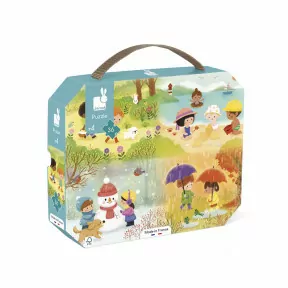
Puzzle Seasons - 36 pieces
Let's discover the cycle of the seasons with the help of a pretty puzzle with soft and colourful illustrations! This cardboard puzzle has 36 pieces and is ideal for teaching children about the 4 seasons and their particularities. With poetic illustrations and pieces adapted to the size of little hands, children from 4 years old will enjoy putting the pieces together and naming the seasons! It's a fun puzzle for learning and developing dexterity while having fun. In its small case, you can store all the pieces and transport your puzzle easily! With the help of the poster that serves as a template, you can assemble it at your own pace! This puzzle made in France. The forest-based material in this product is recycled. It is decorated with vegetable inks.
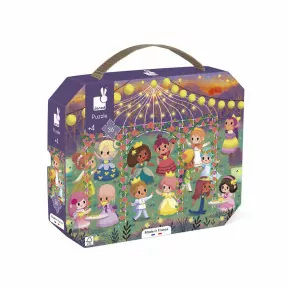
Puzzle Princesses - 36 pieces
Princes and Princesses are organising a small reception and your child is invited! Join the princesses for a moonlit ball with this 36-piece cardboard puzzle. A fun way to develop children's dexterity and memory. Comes in a nice little case, for easy transport and very convenient storage of the pieces. This delightful puzzle comes with a poster serving as a template, to help children from 4 years old to complete their puzzle at their own pace. The forest-based material in this product is recycled. This puzzle made in France is irresistible!
It's puzzle time with a 50+ piece puzzle! Suitable for children aged 5 and over, this activity is great for the whole family's memory and logic. Do you prefer dragon, landscape or animal puzzles? Use the included template or challenge yourself to complete the puzzle on your own, to challenge your brain!
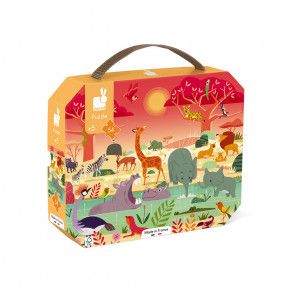
Puzzle Animal Reserve - 54 PCS
It’s time for children to embark on a safari in the midst of nature whilst the sun sets across the African plains! This magnificent 54-piece cardboard puzzle with lots of details and warm tones promises a change of scenery. The calm savannah and many depicted animals are an invitation to escape! This puzzle will help develop the memory and dexterity skills of children aged 5 years and up. This puzzle can easily be carried everywhere, thanks to its awesome fabric-handled suitcase-shaped box. Includes a poster that serves as a model for beginners. After a while, they will then be able to complete the puzzle on their own. The forest-based material in this product is mix FSC®.
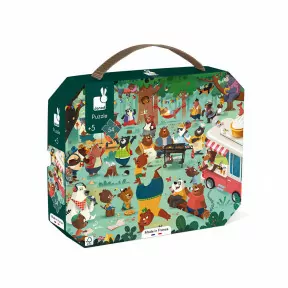
Puzzle Family Bears - 54 PCS
Fancy attending the big bear family reunion in the heart of the forest, whilst developing memory and dexterity skills? This much we promise with this awesome 54-piece cardboard puzzle! A scene in the heart of nature, which conveys love and sharing in a celebration-filled atmosphere... children will be besotted as they discover the details of this beautifully-illustrated design, piece by piece. This puzzle is easy to carry in its fabric-handled suitcase-shaped box. Contains a poster that serves as a model for beginners; the more experienced will soon thereafter be able to complete the puzzle by themselves. This puzzle - suitable for children aged 5 years and over - has discovery written all over it! This puzzle is made in France using mix FSC™ cardboard and vegetable-based inks.
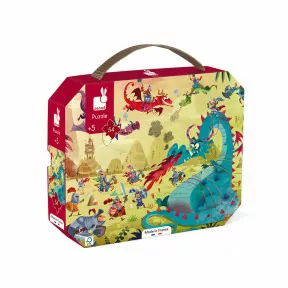
Puzzle Dragons 54 pieces
Help the knights to fight the dragons! Children from the age of 5 are going to be fascinated by these lovely drawings. The puzzle measures 50 x 40 cm when completed. In its pretty little case, this puzzle will be easy to transport thanks to its fabric handle. Contains a poster that serves as a model. Number of pieces: 54. The forest-based material in this product is recycled. Made in France.
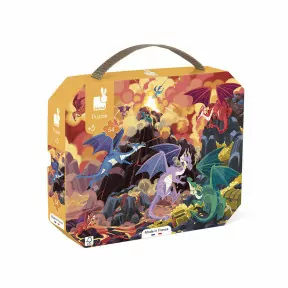
Puzzle Fiery Dragons- 54 pieces
Hot on the trail! The volcano is erupting and the dragons are out: will they fly away or compete to protect their treasures? Embark on a fantastic adventure with this 54-piece dragon-themed cardboard puzzle! A fun way to develop the memory and dexterity of children from the age of 5. This puzzles comes in a case with handle and is very easy to store and transport! A poster serving as a template is provided to guide little ones as they complete the puzzle. This puzzle is made in France and decorated with vegetable inks. The forest-based material in this product is recycled.
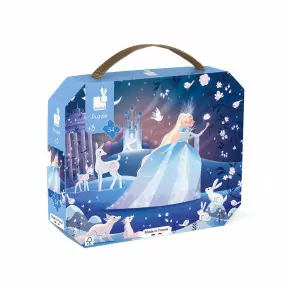
Puzzle Icy Enchantment - 54 pcs
Dive into the snowy world of the Ice Queen, while developing your memory and dexterity, with this beautiful 54-piece cardboard puzzle. In its pretty little case, this puzzle will be easy to transport thanks to its fabric handle. Contains a poster that serves as a model for beginners, with the more experienced then able to complete the puzzle on their own. The forest-based material in this product is mix FSC®. Made in France.
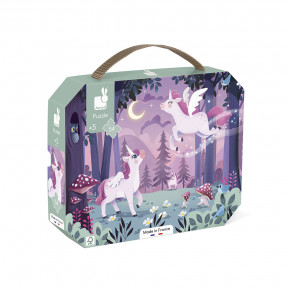
54-piece unicorn puzzle
Ah, unicorns! Immerse yourself in their fairytale world with this 54-piece illustrated puzzle, suitable for children aged 5 and over. This enchanting 50x40 cm puzzle immerses the whole family in the heart of a magical forest, populated by fantastic little creatures, where unicorns have a field day! The pieces are perfectly suited to the small hands of 5-year-olds, and help develop their fine motor skills and logic. This unicorn puzzle is also ideal for stimulating concentration and patience. The poster supplied can be used as a model to help children assemble the puzzle. The result is an immersive, poetic scene that's the stuff of dreams! In the moonlight, the enchanted forest awakens and all its inhabitants shine with their magical powers. Both the puzzle and its model poster come in an attractive carrying case with handle for convenient storage and transport. With this puzzle, children and adults can share a moment of calm and serenity: it's an opportunity to stimulate the imagination and fill the little ones with wonder. Let yourself be carried away by the enchantment of unicorns! Made in France, this puzzle is produced with vegetable-based inks and FSC™ cardboard.
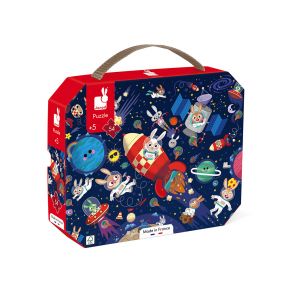
Rocket Puzzle 54 pieces
Bunny 1 for Bunny 2, are you ready for the Carrot mission? Set off on a very important mission with this illustrated puzzle that combines carrots, space and astro-rabbits, and is suitable for children aged 5 years and up. This 54-piece cardboard puzzle features a space race adventure with rabbits at the helm. It comes with a poster that can be used as a model. The pieces are perfectly suited to little hands and help develop fine motor skills. This puzzle is ideal for stimulating toddlers’ concentration and patience. The set comes in a pretty suitcase-style box with a handle, which makes it practical for both storage and transport. Children and adults can bond while attempting to complete this puzzle. A great opportunity to partake in a fun yet crazy adventure and stimulate little ones’ imaginations. So, are you ready to board the Carrot rocket? This puzzle is made in France with vegetable inks and FSC™ cardboard.
The 100-piece jigsaw puzzle is the perfect way to learn a child's favorite theme! The greater the number of pieces, the greater the "wow" effect when the puzzle is finished. To guarantee calm and concentration, suggest a dinosaur puzzle or a world map puzzle to children aged 6 or 7: they'll enjoy learning as they complete the activity.
From 100 pieces upwards, puzzles are richer, inviting young and old to take the time to observe every detail. As with a panoramic puzzle, for example: accompanied by explanations, the puzzle becomes a real learning aid. A puzzle depicting a famous painting or work of art is a great initiation for little artists, enabling them to discover famous painters like Klimt or Da Vinci while having fun!
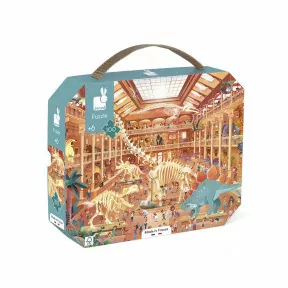
Natural History Museum Puzzle - 100 pieces
How about spending the afternoon at the Natural History Museum? Admire life-size dinosaurs and rediscover great classics from History with this 100-piece cardboard puzzle. With a wealth of details, this richly illustrated puzzle promises long periods of learning and observation! An ideal way to develop children's dexterity and memory while having fun. With its large number of pieces, this puzzle is bound to make young and old, over the age of 6, dream of being immersed in the heart of the museum. It’s so easy to put all the pieces away and carry your puzzle in its pretty case! It comes with a poster that serves as a template to guide the child as they make it. Decorated with vegetable inks, this puzzle is made in France. The forest-based material in this product is recycled. So, do you have your entrance ticket?
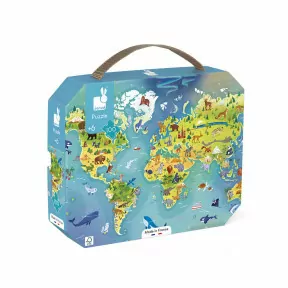
World Puzzle - 100 pieces
From Sydney to Los Angeles, discover the mythical monuments and animals that inhabit the planet with this 100-piece cardboard puzzle! Budding explorers and young geography fans from 6 years old will be delighted. Illustrated in great detail, this beautiful puzzle will help your child develop their memory and dexterity. With its large number of pieces, this is a puzzle that promises great challenges and long moments of fun! It comes with a poster that serves as a reference to guide the child when they first make it. Very practical, the puzzle is stored in its pretty case with handle for easy storage and transport! This puzzle is made in France using mix FSC™ cardboard and vegetable-based inks.
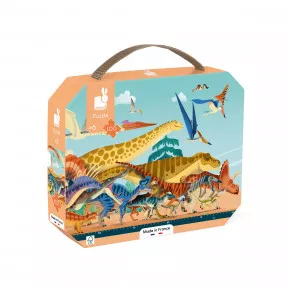
Dino - Panoramic Dino Puzzle
Curious little ones, would you like to recreate a large one-metre-long frieze featuring lots of dinosaurs in their environment, according to the period during which they lived? Thanks to this 100-piece puzzle for children aged 6 years and up, we can learn more about the fascinating dinosaurs whilst having fun! During which period did the Triceratops live? Triassic, Jurassic or Cretaceous? Find the answer in this superb panoramic puzzle. First off, reconstruct the strip using concentration and logic, and the help of the full-size poster, if necessary. The puzzle boasts more than 40 creatures, whilst the frieze at the bottom of the puzzle indicates the years and periods to help provide a clearer chronology of these creatures’ presence on earth. This cardboard puzzle is made in France using eco-friendly vegetable-based inks. Mix FSC®-certified. The attractive case makes it possible to store and transport your puzzle everywhere.
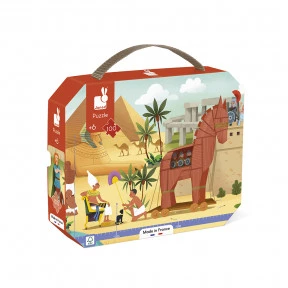
Puzzle Frieze Mythology & Antiquity 100 pieces
Ready for a trip back in time? Immerse yourself in the era of the first great empires with this 100-piece illustrated frieze on the theme of Antiquity and Mythology, suitable for children aged 6 and over. This 100 x 20 cm panoramic puzzle offers total immersion in the period of history that shaped the foundations of our civilization. The pieces are perfectly suited to the small hands of 6-year-olds, helping to develop their fine motor skills. This educational puzzle is also ideal for stimulating concentration and patience. It's a fun way to learn history! The poster supplied can be used as a model and also contains historical information to support the educational aspect of the puzzle. The frieze serves as a roadmap to help children discover this era of myths and legends. They can then use the puzzle as a search-and-find tool, challenging themselves to spot all the details that abound in our puzzle, from the largest, like the Trojan horse, to the smallest, like the cats worshipped in ancient Egypt. The whole set comes in an attractive carrying case with handle for convenient storage and transport. With this puzzle, children and adults can share a moment of calm and serenity: it's an opportunity to learn and stimulate the little ones' imagination. So, are you ready for a journey through time? Made in France, this puzzle is produced with vegetable-based inks and FSC™ cardboard.
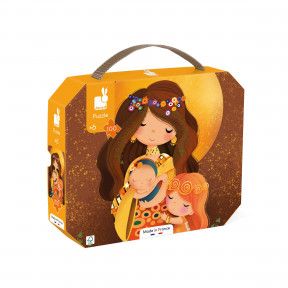
Puzzle Inspired By Klimt - 100 Pcs
Let’s familiarise toddlers with some of the greatest artists ever with these puzzles inspired by famous paintings! This wonderful 100-piece puzzle boasts typical Gustav Klimt-typical style elements: a maternal love scene with lots of colours, golden details and small yet pretty geometric elements. Introduce children aged 6 years and up to the world of painting by plunging them into a warm-coloured puzzle that requires both patience and logic. The included poster can serve as an aide for first-timers. This puzzle is made in France using mix FSC™ cardboard and vegetable-based inks. Once playtime is over it can be stored in the easy-to-carry box with a handle. Did you know? Gustav Klimt was a 19th century Austrian painter. The painter was born into a family of artists: his mother was an opera singer and his father owned a goldsmith's workshop.
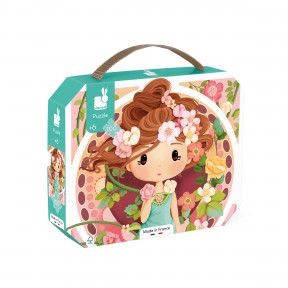
Puzzle Inspired By Mucha - 100 Pcs
Let’s familiarise toddlers with some of the greatest artists ever with these puzzles inspired by famous paintings! This wonderful 100-piece puzzle boasts Alphonse Mucha-typical style elements: the portrait of a young woman, soft, warm colours, and floral details. Introduce children aged 6 years and up to the world of painting by plunging them into an Art Nouveau puzzle that requires both patience and logic. The included poster can serve as an aide for first-timers. This puzzle is made in France using mix FSC™ cardboard and vegetable-based inks. Once playtime is over it can be stored in the easy-to-carry box with a handle. Did you know? Alphonse Mucha was a Czech painter. When he was young, he was refused entry to the Academy of Fine Arts in Prague. In 1900, 22 years later, he took part in the Paris Exposition and was awarded the Legion of Honour for his contribution.
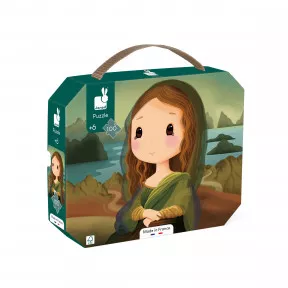
Puzzle Inspired By Leonardo Da Vinci - 100 Pcs
Let’s familiarise toddlers with some of the greatest artists ever with these puzzles inspired by famous paintings! Farewell enigmatic Mona Lisa, hello this fun yet still educational retouched version! This wonderful 100-piece puzzle was inspired by Leonardo da Vinci’s famous masterpiece; the magnificent portrait was painted over 500 years ago! This version of Mona Lisa boasts childish features that will delight both puzzle and art fans alike! Children aged 6 years and up will need to be patient and use their logic to reconstruct this cardboard puzzle; furthermore, they will be introduced to the world of painting and in particular, Renaissance works of art. The included poster can serve as an aide for first-timers. This puzzle is made in France using mix FSC™ cardboard and vegetable-based inks. Once playtime is over it can be stored in the easy-to-carry box with a handle. Did you know? Leonardo da Vinci only painted about twenty works in his lifetime. The most famous, the Mona Lisa, was bought by Francis I of France. This portrait is currently on display at the Louvre Museum in Paris.
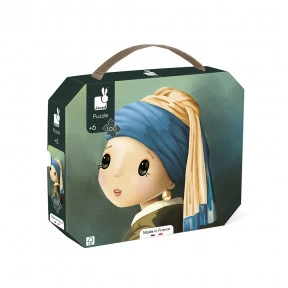
Vermeer-inspired puzzle 100 pieces
The greatest artists are within the reach of toddlers with these puzzles inspired by the greatest painters! This beautiful 100-piece puzzle features a work by Vermeer: The Girl with the Pearl. From age 6 upwards, introduce children to the world of painting by immersing them in a portrait puzzle that requires patience and logic. A poster is included to help children get started. This puzzle is made in France using mixed FSC™ cardboard and vegetable-based inks. Once the puzzle is complete, it can be stored in the easily transportable box thanks to its handle. Did you know? Johannes Vermeer was a 17th-century Dutch painter. This work is also known as the Mona Lisa of the North.
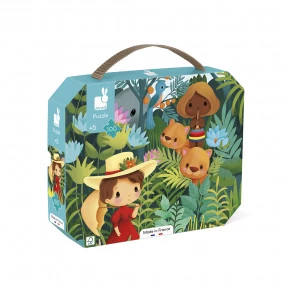
Rousseau-inspired puzzle 100 pieces
The greatest artists are within the reach of toddlers with these puzzles inspired by the greatest painters! In this magnificent 100-piece puzzle, you'll find an element so typical of Rousseau's style: luxuriant nature, inspired by the Jardin des Plantes in Paris. From the age of 6, introduce children to the world of painting by immersing them in an art nouveau puzzle that requires patience and logic. The included poster will help them get started. This puzzle is made in France using mixed FSC™ cardboard and vegetable-based inks. Once the puzzle is complete, it can be stored in the easily transportable box thanks to its handle. Did you know? Henri Rousseau was a self-taught painter and was nicknamed Le Douanier, after his profession.
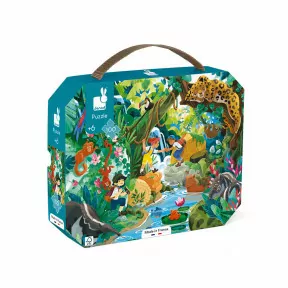
Puzzle Adventure Inca- 100 PCS
Explore the jungle in search of an Inca temple, while developing your memory and dexterity, with this beautiful 100-piece cardboard puzzle. In its pretty little case, this puzzle will be easy to transport thanks to its fabric handle. Contains a poster that serves as a model for beginners, with the more experienced then able to complete the puzzle on their own. The forest-based material in this product is recycled. Made in France.
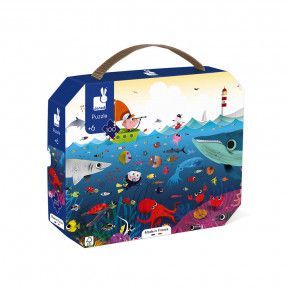
Puzzle Underwater World 100 pieces
Go 20,000 leagues under the sea to explore the depths and its creatures! A little boy in his boat might be in for a surprise! Children from the age of 5 are going to be fascinated by these lovely drawings. The puzzle measures 50 x 40 cm when completed. Contains a poster that serves as a model. Number of pieces: 100. The forest-based material in this product is recycled. Made in France.
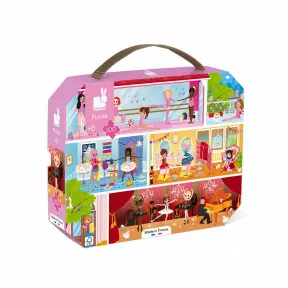
Danse Academy Puzzle 100 pieces
Welcome to the dance academy! Children from the age of 5 are going to be fascinated by these lovely drawings. The puzzle measures 50 x 40 cm when completed. In its little round case, this cardboard puzzle will be easy to transport thanks to its fabric handle. Contains a poster that serves as a model. Number of pieces: 100. The forest-based material in this product is mix FSC®. Made in France.
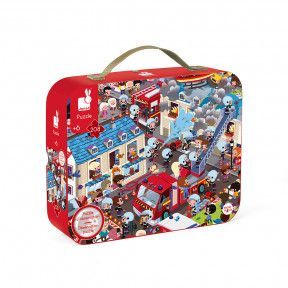
Round Observation Puzzle Firemen 208 pieces
2 games in 1 : a 208-piece round puzzle with amazing details, in an attractive round shaped gift box with handle and an observation game : once the puzzle is assembled, the child needs to find the 51 pictures that are shown around the puzzle, in the completed picture. 50 cm diam puzzle. Poster included. This product is made of FSC® -certified and other controlled material.
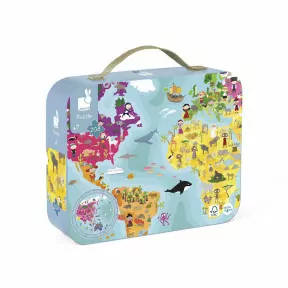
WORLD BOTH SIDE ROUNDED PUZZLE - 208 PCS
Cardboard puzzle of 208 pieces based on The Blue Planet (double-sided) presented in a nice packaging, easy to carry thanks to its handle. Puzzle 50 x 50 cm. This product is made of FSC® -certified and other controlled material.
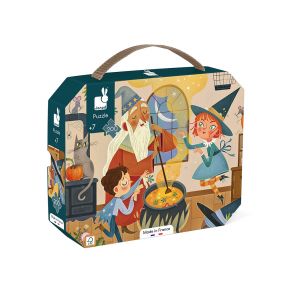
Magic Puzzle 200 pieces
Would-be sorcerers and enchantresses should take a seat as they get an exclusive sneak peek of our magicians' workshop! The magic potion is in the making; children aged 7 years and up are tasked to discover its secret by completing the puzzle. This 200-piece magic-themed illustrated puzzle will fascinate the young and old alike with its numerous details. As soon as you open the suitcase, the adventure begins: a 50 x 40 cm picture will come to life before the amazed eyes of your children who will take up the challenge, whilst developing their fine motor skills and concentration. However, this puzzle is much more than just a game, it is a calm and soothing activity. To guide little ones through the adventure, a poster is provided which can either be used as a model or children’s bedroom decoration. So, are you ready to embark on this fabulous adventure with your family? Magic potions are at your fingertips... abracadabra! This puzzle is made in France with vegetable inks and FSC™ cardboard.
Take the time to get together, alone or with others, to solve a puzzle of 200 pieces or more: for children aged 7 and over, and even for older children, the richness and poetry of the illustrations invite you to take a break away from your screens.
A walk in the garden? An afternoon in Paris? How about a cruise? With a jigsaw puzzle, anything is possible without leaving the comfort of home!
Ready for a challenge? Choose a 500-piece puzzle! Immersive and dreamlike, adults and children aged 8 and over love them. Beautiful landscapes, animals... Here you go, alone or with your family, for a relaxing activity that stimulates your brain. The puzzle's 500-piece size gives it a certain complexity, but above all a certain beauty: how satisfying once it's assembled!
Find the dimensions of all our Janod puzzles over 500 pieces on our product sheets and on the back of the box. These are puzzles you'll want to make, frame and display at home!
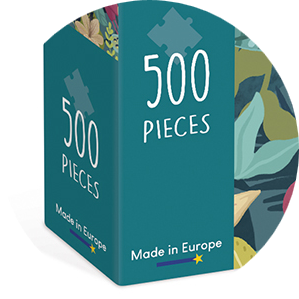

Puzzle At The Market 500 pieces
On the way to the farmers' market! This 500-piece puzzle on the theme of the market invites you to return to childhood: the smell of pastries and warm bread, the colorful stalls, the pigeons on the main square ... All you have to do is let yourself be guided by grandmother, who has her little habits and preferences! Ideal for children from 8 years old, and for the whole family, this puzzle invites you to discovery and relaxation. The large number and size of the pieces make this puzzle a real challenge where attention to detail and logic will be essential to reproduce the beautiful illustration. Make yourself comfortable and enjoy your puzzle evening to relax with a fun and relaxing activity! There is nothing better to occupy your evenings without a screen. "Whether you have a bottomless basket or a well-filled backpack, don't forget to enjoy the little things in life." is the message of this puzzle with a universal theme, which will send you back to your childhood. Stocking up on seasonal produce and meeting those who make them, eating fresh fruit and vegetables, discovering taste from childhood: this is what a visit to the market evokes! Once assembled, this 48x34 cm puzzle will be a beautiful, colorful object to frame. Made of cardboard and paper from sustainably managed forests, this puzzle is FSC™ certified. Made in Poland, it is decorated with vegetable inks. And why not choose a beautiful bouquet to decorate the dining room when you return from shopping?
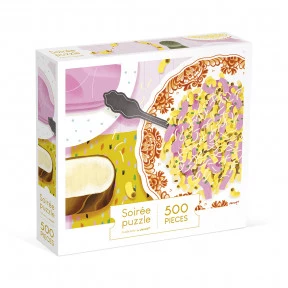
Puzzle Pasta and ham 500 pieces
What if we went back to our childhood? This 500-piece puzzle represents a real Proust madeleine, a comforting and very popular dish in France: "coquillettes jambon"! A combination of creamy and tasty ingredients, a quick and easy dish to prepare, so loved by little ones… Ideal for children from 8 years old, and for the whole family, this puzzle with the theme of this dish synonymous with childhood memories invites you to indulge and relax. The large number and size of the pieces make this puzzle a real challenge where attention to detail and logic will be essential to reproduce the pretty illustration. Make yourself comfortable and enjoy your puzzle evening to relax with a fun and relaxing activity! There is nothing better to occupy your evenings without a screen. Whether you always add more grated cheese or prefer noodle necklaces, the original theme of this puzzle will send you straight to the table of your childhood. Indulging in simple dishes, sharing good times at the table or in the kitchen from a young age: this is what the ham and pasta shells evoke! Once assembled, this 34 x 48 cm puzzle will be a beautiful gourmet object to frame. Made of cardboard and paper from sustainably managed forests, this puzzle is FSC™ certified. Made in Poland, it is decorated with vegetable inks. And why not try them in a gratin next time?
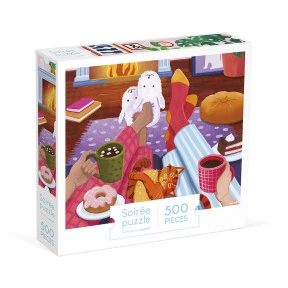
Puzzle Evening by the Fireside 500 pieces
How about relaxing by the fire? This 500-piece puzzle illustrates all the essentials for a cozy moment: a hot drink, a good dessert, warm pajamas... And a pleasant crackling fireplace! Ideal for children from 8 years old, and for the whole family, this puzzle on the theme of an evening by the fire invites you to comfort and relaxation. The large number and size of the pieces make this puzzle a real challenge where attention to detail and dexterity will be essential to reproduce the pretty illustration. Make yourself comfortable and enjoy your puzzle evening to relax with a fun and relaxing activity! There is nothing better to occupy your evenings without a screen. Whether you opt for slippers or socks, the cocooning theme of this puzzle will wrap you in warmth like a soft blanket. Treat yourself to treats, enjoy the moment, and imitate this little ginger cat (who has understood that it is essential to relax): these are the right ingredients for a great evening by the fire! Once assembled, this 34x48 cm puzzle will be a beautiful object to frame. Made of cardboard and paper from sustainably managed forests, this puzzle is FSC™ certified. Made in Poland, it is decorated with vegetable inks. And you, what does your cozy evening of choice look like?
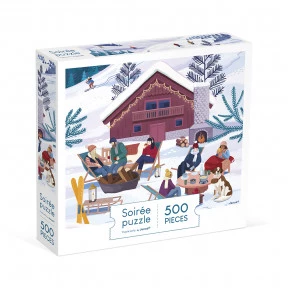
Winter in the Mountains Puzzle 500 pieces
What is your favorite moment after a day spent skiing? This 500-piece puzzle showcases all the essentials of a successful après-ski: a good cheese fondue, a hot chocolate by the fire, a cozy blanket, close friends ... And a breathtaking view of the snow-capped mountains! Ideal for children from 8 years old, and for the whole family, this winter sports-themed puzzle reminds you of your good memories as well as those you will create by assembling it. The large number and size of the pieces make this puzzle a real challenge where attention to detail and dexterity will be essential to reproduce the beautiful illustration. Make yourself comfortable and enjoy your puzzle evening to relax with a fun and relaxing activity! There is nothing better after the effort. Whether you are more comfortable in the chalet or in the powder, on skis or on a sled, the winter theme of this puzzle will transport you to an enchanting landscape. Pushing yourself on the slopes, tasting local specialties, sharing friendly moments with family or friends: these are the right ingredients for a memorable winter vacation! Once assembled, this 34x48 cm puzzle will be a beautiful object to frame. Made of cardboard and paper from sustainably managed forests, this puzzle is FSC™ certified. Made in Poland, it is decorated with vegetable inks. So, wax your skis!
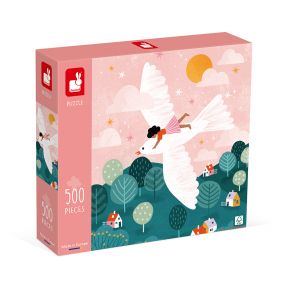
Puzzle The Dove 500 pieces
Embark on a great adventure with our charming dove and their friend! Imagine a world where birds and humans share a deep, sincere and friendly connection. I.e. the story told by our 500-piece puzzle for children aged 8 years and up, including adults. Each puzzle piece will promote calm and relaxation. As children piece the puzzle together, they’ll gradually discover a moving scene: a little girl flying in the sky with a dove with outstretched wings. A bucolic landscape with distinctive colours will come to life before their eyes. The little houses dotted over the countryside rub shoulders with the blue-green trees which boast relatively primitive features. The pink sky contrasts with this environment. Once completed, the puzzle can be framed and hung on the wall to transform your living room into a real art gallery. So, are you ready to escape from everyday stresses? This product is made from FSC®-certified and controlled materials.
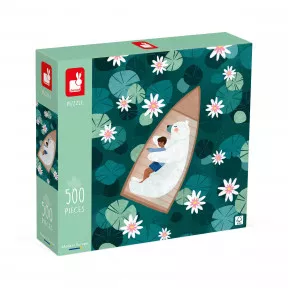
Water Lilies Puzzle 500 pieces
Immerse yourself in a tranquil world with this magnificent Water Lilies puzzle! Imagine yourself sitting on the edge of a peaceful pond with the water lilies gently floating on the surface of the water. This is the sensation conveyed in our 500-piece puzzle that’s suitable for children aged 8 years and over, including adults. Designed for puzzle enthusiasts and nature lovers: it will transport you to a calm and beautiful world. Each piece is an invitation to relax. By assembling the pieces, children will gradually discover a magnificent illustration featuring a polar bear with his arms comfortably and peacefully wrapped around a young child, as they rest amongst the flowering water lilies. This cardboard puzzle is made in Europe. When completed, the puzzle will measure 34 x 48 cm; the ideal size for framing and hanging on the wall. So, are you ready to escape and join these endearing characters on their boat? This game is made from FSC®-certified and controlled materials.
If you're already a jigsaw puzzle fan, the 1000-piece jigsaw puzzle doesn't scare you! Expand your collection or set yourself a new challenge with an original 1000-piece puzzle.
It's also a great gift idea that promises entertainment and relaxation, all in the comfort of your own home.
You can find out the size of your Janod 1000-piece puzzle on the back of the box and directly on our online product sheets, for a fun and engaging activity that leaves plenty of room for escape!

Family Meal Puzzle 1000 pieces
Are you coming to eat on Sunday? This 1000-piece puzzle illustrates the diversity and conviviality of family meals: a large table, dishes set out on both sides... And guests ready to feast, even the cat! Ideal for children aged 8 and over, and for the whole family, this puzzle on the theme of family meals invites you to relax and will remind you of the importance of these shared moments. The large number and size of the pieces make this puzzle a real challenge where attention to detail and logic will be essential to reproduce the pretty illustration. Alone or with others, settle in comfortably and enjoy your puzzle evening to relax with a fun and relaxing activity! There is nothing better to occupy your evenings without a screen. The friendly theme of this puzzle will remind you of the star recipes of your Sunday meals, the laughter and the great discussions. Whether you are there for the food or for the people, you are there, and that's what really matters, right? Once assembled, this 68.3x48 cm puzzle will be a beautiful object to frame. Made of cardboard and paper from sustainably managed forests, this puzzle is FSC™ certified. Made in Poland, it is decorated with vegetable inks. But tell me, who ate all the bread again?
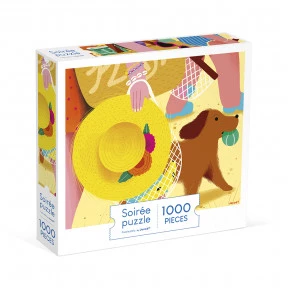
Puzzle Trip to the Beach 1000 pieces
Great, a trip to the beach! This 1000-piece puzzle features all the essentials of a summer day spent by the water: beach games, pearl bracelets, a landing net for fishing for treasures... Not forgetting the hat and sunglasses, essential for the season! Ideal for children from 8 years old, and for the whole family, this puzzle on the theme of a trip to the beach invites you to relax and will remind you of your family vacation by the sea. The large number and size of the pieces make this puzzle a real challenge where attention to detail and logic will be essential to reproduce the pretty illustration. Alone or with others, make yourself comfortable and enjoy your puzzle evening to relax with a fun and relaxing activity! There is nothing better to occupy your evenings without a screen. The summer theme of this puzzle will remind you of the smell of pine trees, the song of cicadas or even the sea air. Basking in the sun, enjoying the moment, reading a good book or playing in the waves: these are the perfect activities for a successful beach trip! Once assembled, this 48x68.3 cm puzzle will be a beautiful object to frame. Made of cardboard and paper from sustainably managed forests, this puzzle is FSC™ certified. Made in Poland, it is decorated with vegetable inks. So, shall we come back tomorrow?
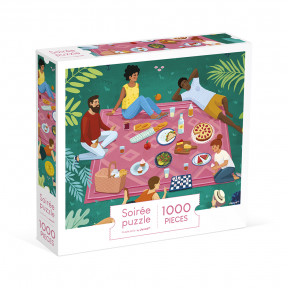
Puzzle Picnic With Friends 1000 pieces
Ready for a big picnic? This 1000-piece puzzle features all the essentials for a friendly moment in the great outdoors: a large tablecloth, simple but tasty dishes, children playing... And greenery as far as the eye can see! Ideal for children aged 8 and over, and for the whole family, this puzzle on the theme of a picnic with friends invites you to relax and will remind you of moments of shared indulgence. The large number and size of the pieces make this puzzle a real challenge where attention to detail and logic will be essential to reproduce the pretty illustration. Alone or with others, sit back and enjoy your puzzle evening to relax with a fun and relaxing activity! There is nothing better to occupy your evenings without a screen. Whether you come for the setting or for the meal, the festive theme of this puzzle will make you want to savor every moment. Getting some fresh air, enjoying the moment, and snacking on everything you like: these are the right ingredients for a successful picnic with friends! Once assembled, this 48 x 68.3 cm puzzle will be a beautiful object to frame. Made of cardboard and paper from sustainably managed forests, this puzzle is FSC™ certified. Made in Poland, it is decorated with vegetable inks. So, see you at the park, and don't forget the napkins!
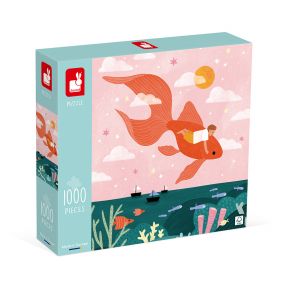
Dream at Sea Puzzle 1000 pieces
Dive into a mystery-filled ocean with our marine puzzle! This 1000-piece puzzle is perfect for children aged 8 years and up. Explore the underwater world in a fun yet educative way. This puzzle will stimulate children's dexterity and concentration, whilst letting them discover the beauty of marine life. Whether alone or in a group, this activity is ideal for having a calm yet enriching time. The 1000 pieces of this adult puzzle have been carefully designed to reproduce a magnificent marine illustration, where the sky and the sea become one. Stars visible in broad daylight and a majestic fish breaching the water: universes combine to form a world full of possibilities. The boats in the distance merge with the sea creatures in the foreground, and the corals seem ready to pierce the sky. It is in this dream at sea that a little boy travels the skies. Will he dive under to discover the underwater world with you? Once assembled, this puzzle can be framed to become a stunning wall decoration. The green and pink tones of this adult puzzle will appeal to the whole family. By completing this puzzle, children can imagine themselves as real deep sea explorers. It's a great way to stimulate their imagination through play. This puzzle is made in Europe from FSC®-certified and controlled materials.
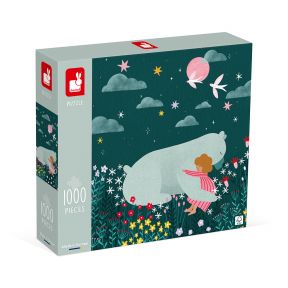
Friendship Puzzle 1000 pieces
A sweet moment beneath the starry sky. A wonderful time is in store with this 1000-piece puzzle, designed for children aged 8 and over and their parents. This friendship-themed puzzle is more than just a game, it's an adventure in the making. In this clearing where wildflowers bloom, two friends hug each other at nightfall. A little girl and her bear friend are getting ready to say goodnight, or maybe they could just really do with a hug. Feel the softness and warmth emanating from the bear cocooning their friend; he epitomises the comfort and care that every friendship brings. Together, they are confident and peaceful, and the night becomes magical. Each piece of the puzzle takes you a step further on this journey, providing an enriching playtime that stimulates concentration, patience and problem-solving skills. Children and their parents can bond and be at peace whilst assembling this puzzle. They can all relax and forget (if only temporarily) their everyday stress. The product comes in a pretty box that is ideal for gifting or storing the pieces. Discover the joy of solving puzzles with our 1000-piece friendship puzzle, and create treasured memories whilst stimulating your mind. Much more than a game: it's a journey into the world of friendship. This puzzle is made in Europe from FSC®-certified and controlled materials.
Adding real educational value to a puzzle is a great way for kids to learn without even noticing! From ages 2 to 10, children can manipulate the pieces of their educational jigsaw puzzle, making learning more concrete. Number or alphabet puzzles for pre-schoolers, human body puzzles for natural science enthusiasts: the number of pieces is adapted to the youngest children, who enjoy learning while having fun!
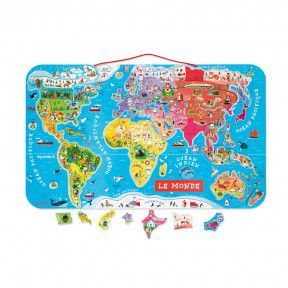
Magnetic World Map Puzzle French Version 92 pieces (wood) - In French Only
Ready to go on an adventure? Then let's go around the world in 92 magnets! This magnetic world map puzzle will allow children from 7 years old to discover the beautiful countries and cultures of our planet while having fun. Each magnet represents a country or a region of the world, with its name, its capital and an illustration characterising that part of the world. Children have fun finding the location of each country, observing and learning about their specificities and can enjoy this beautiful world map by hanging it on their bedroom wall, for instance. The large magnetic board, with its rounded shapes, represents the world with its continents, seas and oceans: the colour used for each region allows you to get your bearings. A fun and educational way to discover the planet! The map includes a cotton string to hand the puzzle on the wall.
>> The Magnetic World Map Puzzle has been tried and loved by the children, see here!
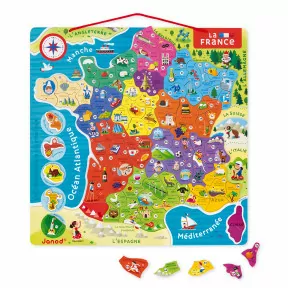
Magnetic France Map 93 pieces - French (wood) - In French Only
How about an easy and fun tour of France with this beautiful magnetic map with colourful and lively illustrations! This educational puzzle of the French departments is a must-have map of France for 7 to 12 year olds! They will enjoy discovering the 13 French regions, through the 93 magnets to be placed in the right place on the map. The little ones will become geography experts! Each magnet shows the number and name of the department, the capital and a drawing of a local speciality. The magnetic board shows the regions, major rivers, mountain ranges, seas, oceans, overseas departments and border countries. So you can travel without leaving your house and see where your grandparents live! The puzzle is made of wood and can be fixed to the wall thanks to the integrated red cord.

Magic Forest Puzzle
This is a new kind of puzzle that children are bound to love! What’s so special about it? It’s magic, that’s what! This 24-piece puzzle will help children aged 3 and over to discover nocturnal animals, thanks to its special lamp that reveals all sorts of hidden details! Are you ready to explore the secrets of the forest in the middle of the night? In that case, you should start by completing this delicately coloured jigsaw. Then switch on the little magic lamp to sneak a look at owls, squirrels and hedgehogs going about their nocturnal business! The hidden elements will suddenly appear in whites and yellows! The pieces are large enough for even the smallest toddlers to grab hold of. This incredible 2-in-1 puzzle will spark children’s curiosity as they try to discover more about the little forest-dwellers picked out by the light! A poster is included to help younger toddlers. This product is made of FSC® -certified and other controlled material.

Ocean Magic Puzzle
This is a new kind of puzzle that children are bound to love! What’s so special about it? It’s magic, that’s what! This 24-piece puzzle will help children aged 3 and over to discover the seabed, thanks to its special lamp that reveals all sorts of hidden details! Are you ready to explore the depths? In that case, you should start by completing this delicately coloured jigsaw. Then switch on the little magic lamp to sneak a look at octopuses, sea anemones and jellyfish going about their nocturnal business! The hidden elements will suddenly appear in blues and yellows! The pieces are large enough for even the smallest toddlers to grab hold of. This incredible 2-in-1 puzzle will spark children’s curiosity as they try to discover more about the little ocean-dwellers picked out by the light! A poster is included to help younger toddlers. This product is made of FSC® -certified and other controlled material.

Sea Animals Frieze Puzzle 36 pieces
Discover the depths of the ocean! Dive in search of marine animals with this 36-piece illustrated frieze on the theme of sea creatures, suitable for children aged 4 and over. This 100 x 20 cm panoramic puzzle offers total immersion in the ocean depths. The pieces are perfectly suited to the small hands of 4-year-olds, helping to develop their fine motor skills and logic. This marine puzzle is also ideal for stimulating concentration and patience. The poster supplied can be used as a model to help children assemble the puzzle. The result is an enchanting panorama, as if they were sailing aboard a submarine like sea explorers! They can then use the puzzle as a search-and-find game, challenging themselves to locate and name all the marine animals hidden inside. The whole set comes in an attractive carrying case with handle, making it easy to store and transport. With this puzzle, children and adults can share a moment of calm and serenity: it's an opportunity to stimulate the little ones' imagination. So get on board together! Made in France, this puzzle is produced with vegetable-based inks and FSC™ cardboard.

Dino - Panoramic Dino Puzzle
Curious little ones, would you like to recreate a large one-metre-long frieze featuring lots of dinosaurs in their environment, according to the period during which they lived? Thanks to this 100-piece puzzle for children aged 6 years and up, we can learn more about the fascinating dinosaurs whilst having fun! During which period did the Triceratops live? Triassic, Jurassic or Cretaceous? Find the answer in this superb panoramic puzzle. First off, reconstruct the strip using concentration and logic, and the help of the full-size poster, if necessary. The puzzle boasts more than 40 creatures, whilst the frieze at the bottom of the puzzle indicates the years and periods to help provide a clearer chronology of these creatures’ presence on earth. This cardboard puzzle is made in France using eco-friendly vegetable-based inks. Mix FSC®-certified. The attractive case makes it possible to store and transport your puzzle everywhere.
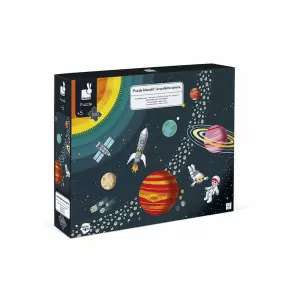
Educational Puzzle Solar System
Aim for the Milky Way and to discover our solar system with this magnificent space-themed puzzle, suitable for children aged 5 years and up! This 100-piece cardboard puzzle is an invitation to escape into a world that mesmerises children! Comets, the sun, a few planets and beautiful details to discover in total immersion, thanks to this large-sized puzzle (70 x 49 cm). It comes with an educational booklet so your child can learn more about our solar system and its celestial bodies. As far as the style is concerned, this predominantly matte puzzle boasts varnish-finished planets to make them stand out and be easily identifiable. The box also contains a poster that serves as a model for beginners; the more experienced will soon thereafter be able to complete the puzzle by themselves. This product is made of FSC® -certified and other controlled material.

Round Observation Puzzle Firemen 208 pieces
2 games in 1 : a 208-piece round puzzle with amazing details, in an attractive round shaped gift box with handle and an observation game : once the puzzle is assembled, the child needs to find the 51 pictures that are shown around the puzzle, in the completed picture. 50 cm diam puzzle. Poster included. This product is made of FSC® -certified and other controlled material.
What better way to start learning geography than with a world map puzzle! Children use the colors and illustrations to place the pieces of their world map puzzle in the right place: a great way to learn how to find their bearings in space and learn about the cultures of the world's countries!

Magnetic World Map Puzzle French Version 92 pieces (wood) - In French Only
Ready to go on an adventure? Then let's go around the world in 92 magnets! This magnetic world map puzzle will allow children from 7 years old to discover the beautiful countries and cultures of our planet while having fun. Each magnet represents a country or a region of the world, with its name, its capital and an illustration characterising that part of the world. Children have fun finding the location of each country, observing and learning about their specificities and can enjoy this beautiful world map by hanging it on their bedroom wall, for instance. The large magnetic board, with its rounded shapes, represents the world with its continents, seas and oceans: the colour used for each region allows you to get your bearings. A fun and educational way to discover the planet! The map includes a cotton string to hand the puzzle on the wall.
>> The Magnetic World Map Puzzle has been tried and loved by the children, see here!

World Puzzle - 100 pieces
From Sydney to Los Angeles, discover the mythical monuments and animals that inhabit the planet with this 100-piece cardboard puzzle! Budding explorers and young geography fans from 6 years old will be delighted. Illustrated in great detail, this beautiful puzzle will help your child develop their memory and dexterity. With its large number of pieces, this is a puzzle that promises great challenges and long moments of fun! It comes with a poster that serves as a reference to guide the child when they first make it. Very practical, the puzzle is stored in its pretty case with handle for easy storage and transport! This puzzle is made in France using mix FSC™ cardboard and vegetable-based inks.

WORLD BOTH SIDE ROUNDED PUZZLE - 208 PCS
Cardboard puzzle of 208 pieces based on The Blue Planet (double-sided) presented in a nice packaging, easy to carry thanks to its handle. Puzzle 50 x 50 cm. This product is made of FSC® -certified and other controlled material.
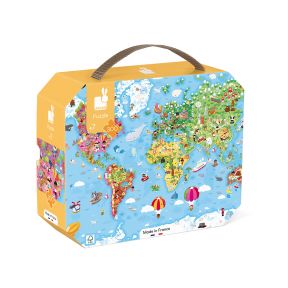
Giant of the World Puzzle 300 pieces
Embark on a journey around the world with our giant multicoloured puzzle! Discover the world like never before with this giant 300-piece puzzle for children aged 7 years and up. A different colour represents each continent to create a vibrant mosaic of our planet with ultra-detailed illustrations. An effective and fun way to learn geography and discover the specialities of each country. A poster is included to help children piece the puzzle together and increase their knowledge. Children can occasionally check the poster to monitor their progress. And once complete, storage is child's play! Our puzzle can easily be stored in its pretty case with an easy-to-carry fabric handle. Children can take the puzzle wherever they may go, turning every moment into a fun opportunity to learn. This large puzzle measures 99 x 69 cm and becomes a beautiful planisphere once completed. It is made in France from FSC™-certified materials. So, are you ready to discover the world with your family in an exciting way? Grab the puzzle and let the adventure begin!
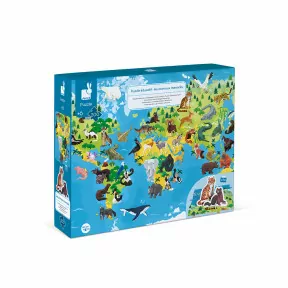
Educational Puzzle Endangered Animals
For Jurassic fans, the 200-piece dinosaur puzzle combines challenge and learning in the world of dinos. And for volume creations, a 3D dinosaur puzzle is a great construction set that you can keep once assembled to decorate your bedroom!
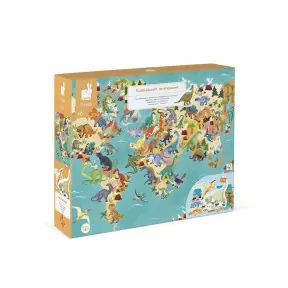
Educational Puzzle The Dinosaurs
This magnificent giant educational cardboard puzzle will allow children aged 6 years and up to discover the wonderful world of dinosaurs. The 200-piece puzzle also comes with an educational booklet for youngsters to learn more about these incredible creatures and discover what sets them apart. 50 cardboard dinosaurs can also be assembled and placed on the puzzle: a fun and entertaining activity! The names of the dinosaurs are indicated on the back of each figurine. This giant dinosaur puzzle will serve as an introduction to geography for your child, whilst they get to learn more about these fascinating creatures. Contains a poster that serves as a model for beginners, with the more experienced then able to complete the puzzle on their own. This product is made of FSC® -certified and other controlled material.

Dino - Panoramic Dino Puzzle
Curious little ones, would you like to recreate a large one-metre-long frieze featuring lots of dinosaurs in their environment, according to the period during which they lived? Thanks to this 100-piece puzzle for children aged 6 years and up, we can learn more about the fascinating dinosaurs whilst having fun! During which period did the Triceratops live? Triassic, Jurassic or Cretaceous? Find the answer in this superb panoramic puzzle. First off, reconstruct the strip using concentration and logic, and the help of the full-size poster, if necessary. The puzzle boasts more than 40 creatures, whilst the frieze at the bottom of the puzzle indicates the years and periods to help provide a clearer chronology of these creatures’ presence on earth. This cardboard puzzle is made in France using eco-friendly vegetable-based inks. Mix FSC®-certified. The attractive case makes it possible to store and transport your puzzle everywhere.
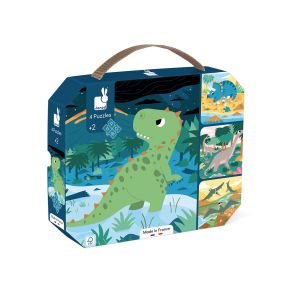
Evolutionary Dinosaur Puzzles - 4 puzzles
A prehistoric journey awaits your little explorers! With these 4 dinosaur-themed evolving puzzles, children aged 2 and over can explore the Jurassic period. Each puzzle – composed of 6, 9, 12 and 16 pieces, respectively – will help your child progress, whilst stimulating their fine motor skills and concentration. A challenge suited for every age! Each puzzle has a different-coloured backing, which helps little ones easily assemble the 4 puzzles. Furthermore, the large pieces fit perfectly into little hands, making play more fun and enjoyable. A fun journey through time: imagine your child's joy when they put the pieces together to reveal a majestic dinosaur, whilst learning to recognise the different species! It's a great way to combine play and learning. Practical: these puzzles come in a carry case with a handle so children can take them wherever they please. Whether going on a trip or visiting their grandparents, your little one can surely take this calm and stimulating activity with them. So, are you ready to embark on a journey through time with our dinosaur puzzles? These puzzles are made in France from FSC™ cardboard and decorated with vegetable inks.

Dino - 4 Progressive Puzzles Dino
Calling all little dinosaur fans! 4 beautiful figurines are all set to entertain little ones, whilst also making them think! Look at these 4 ultra-cute progressive wooden puzzles for babies aged 18 months and up! Start off with the 2-piece puzzle and then gradually increase the difficulty, up to the 5-piece model. Let's bring the 2-piece Triceratops, 3-piece T-Rex, 4-piece Diplodocus, and 5-piece Ankylosaurus back to life. To make this early-years game even easier, the wooden puzzle pieces nestle into 4 bases. This early-learning puzzle is ideal for developing little ones’ dexterity. Made from FSC® wood.

Chunky Puzzle Dinosaurs 7 pieces (wood)
Wooden puzzle on the topic of the dinosaurs. 7 pieces in 3D, thickness of 1,5 cm. Discover the fascinating world of dinosaurs! Your child will have fun putting the animals in the right place and playing with the pieces that stand up just like real figures. Your child will have fun as he or she develops his or her motor skills and imagination.
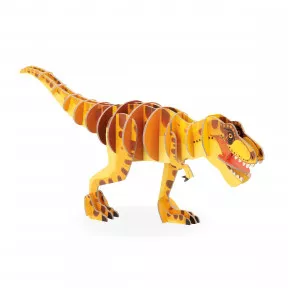
Dino - T-Rex Multidimensional Puzzle
What could be more impressive than bringing the most ferocious dinosaurs of all to life with a 3D puzzle! Assemble the 27 double side-printed cardboard pieces to build this magnificent T-rex in pretty yellow shades! This activity - which is both a construction game and 3D puzzle - is ideal for children aged 5 years and up. The awesome product is constructed without any glue, meaning it can be assembled and disassembled time and time again. It can also be used to decorate the bedrooms of any dinosaur fans! This toy simultaneously develops children’s concentration, logic and imagination. Your child will enjoy building it themselves by following the assembly instructions. It measures 40 cm long when completed. This puzzle is made in France using FSC® mix cardboard and vegetable-based inks.
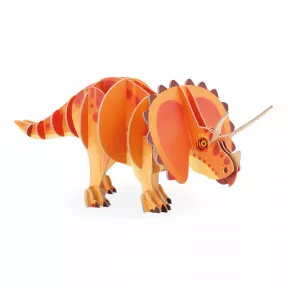
Dino - Triceratops Multidimensional Puzzle
What could be more impressive than bringing the most popular dinosaurs of all to life with a 3D puzzle! Assemble the 32 double side-printed cardboard pieces to build this magnificent triceratops in pretty orange hues; a species that stands out for its large frill and 3 majestic horns on its beak! This activity - which is both a construction game and 3D puzzle - is ideal for children aged 5 years and up. The awesome product is constructed without any glue, meaning it can be assembled and disassembled time and time again. It can also be used to decorate the bedrooms of any dinosaur fans! This toy simultaneously develops children’s concentration, logic and imagination. Your child will enjoy building it themselves by following the assembly instructions. It measures 36 cm long when completed! This puzzle is made in France using FSC® mix cardboard and vegetable-based inks.
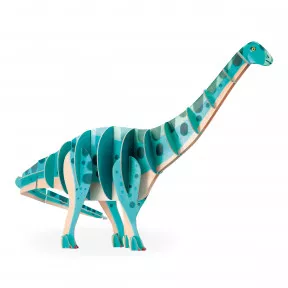
Dino - Diplodocus Multidimensional Puzzle
What could be more impressive than bringing one of the biggest dinosaurs to life with a 3D puzzle! Assemble the 42 double side-printed cardboard pieces to build this magnificent diplodocus in pretty blue tones; a species that stands out for its long neck and tail. This activity - which is both a construction game and 3D puzzle - is ideal for children aged 5 years and up. The awesome product is constructed without any glue, meaning it can be assembled and disassembled time and time again. It can also be used to decorate the bedrooms of any dinosaur fans! This toy simultaneously develops children’s concentration, logic and imagination. Your child will enjoy building it themselves by following the assembly instructions. Once complete, this puzzle measures 54 cm long. The product is made in France using FSC® mix cardboard and vegetable-based inks.
Do they dream of being astronauts? Give them a space puzzle! With the included educational booklet, the planets will no longer hold any secrets for them!
What to do once you've put the puzzle together? Play a game of seek and find, of course! With an observation puzzle, the base becomes a real game board, with a multitude of elements hidden in the background for little ones to find. Firemen's puzzle or fairytale puzzle: here's a game that combines motor skills, concentration, logic and observation!

Educational Puzzle Solar System
Aim for the Milky Way and to discover our solar system with this magnificent space-themed puzzle, suitable for children aged 5 years and up! This 100-piece cardboard puzzle is an invitation to escape into a world that mesmerises children! Comets, the sun, a few planets and beautiful details to discover in total immersion, thanks to this large-sized puzzle (70 x 49 cm). It comes with an educational booklet so your child can learn more about our solar system and its celestial bodies. As far as the style is concerned, this predominantly matte puzzle boasts varnish-finished planets to make them stand out and be easily identifiable. The box also contains a poster that serves as a model for beginners; the more experienced will soon thereafter be able to complete the puzzle by themselves. This product is made of FSC® -certified and other controlled material.

Round Observation Puzzle Firemen 208 pieces
2 games in 1 : a 208-piece round puzzle with amazing details, in an attractive round shaped gift box with handle and an observation game : once the puzzle is assembled, the child needs to find the 51 pictures that are shown around the puzzle, in the completed picture. 50 cm diam puzzle. Poster included. This product is made of FSC® -certified and other controlled material.
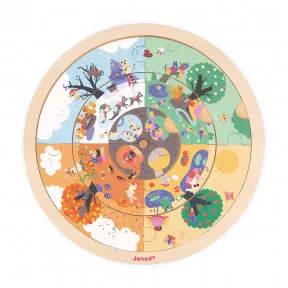
Observation Puzzle - Garden
Following the days and seasons has never been easier! With this Seek and Find puzzle-type game, children aged 4 years and up will better understand the concept of passing time and work on their observation skills. This scalable educational game boasts an activity on each side! The top-side features the events of a day: little ones can then assemble the wooden puzzle pieces, before rotating them to ensure they match on 3 levels. This will help your toddler learn how daily life is broken up and the different periods, from morning to night. On the back of this educational puzzle, the seasons are within reach: your child can also assemble the pieces and move them around to reconstruct the 4 seasons. It's a great way of transforming the concept of time – which little ones find rather abstract – into something very concrete, thanks to the manipulation aspect! Your child will discover pretty nature settings and small animals on both sides of this wooden puzzle. They’ll also have a ball spinning the pieces! This educational game is not just a simple round puzzle, it is also a Seek and Find game which promotes toddlers’ concentration and observation skills! Place the cover provided over one of the sides, then ask your child to find the 10 hidden elements on each puzzle (i.e. 20 in total). Clever design: the 3 cut-outs on the cover allow you to restrict the observation area: ideal for developing visual acuity! This educational game for nursery-age children consists of: 1 round wooden base, 12 wooden puzzle pieces, 20 cards and 1 cardboard cover. This observation puzzle will plunge children into the fun garden world; this environment is teeming with curiosities and ever-evolving, depending on the time of day and seasons. You can have a helping hand in your child’s learning by guiding them as they complete the puzzle, or encouraging them to observe nature through the window or during your next outing; this will reinforce the concept to help them make the connection with the illustrations on the board. This garden-themed Seek and Find game is made from FSC™-certified wood and cardboard. It is part of the Janod educational range, developed in collaboration with a school teacher to ensure the best possible fit with the learning and curriculum at each level.
Nature puzzles are a great way to teach children about ecology and environmental protection! As children assemble the pieces, they discover key elements for a better understanding of green energy or recycling, the importance of the ecosystem, and learn more about endangered animal species. With the help of the animal-shaped puzzle pieces, children can expand their vocabulary and knowledge of footprints and where certain species live.

Educational Puzzle Endangered Animals
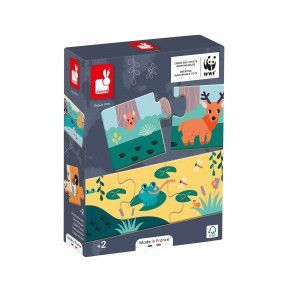
Animal Footprints Puzzle
Learn to identify animals and their footprints with this early-years puzzle... it’s such a great idea! This educational puzzle for children aged 2 years and up serves both as an association and logic game: it will prompt toddlers to enter the midst of the forest and meet animals that are leaving footprints wherever they go! This box includes 10x 3-piece puzzles to be put together by playful little hands. The attractive colourful illustrations allow children to identify the animal's prints on the first piece, the animal on the second, and what it eats on the final piece. The pieces are the ideal size for little hands. This educational toy is made in France from FSC®-certified mix cardboard. Developed in collaboration with the WWF®. Janod is supporting the WWF®'s efforts to protect the environment and biodiversity with a range of toys made from more sustainable materials. With this range, we aim to inspire and empower the younger generation to stand up for wildlife and nature.

Sea Animals Frieze Puzzle 36 pieces
Discover the depths of the ocean! Dive in search of marine animals with this 36-piece illustrated frieze on the theme of sea creatures, suitable for children aged 4 and over. This 100 x 20 cm panoramic puzzle offers total immersion in the ocean depths. The pieces are perfectly suited to the small hands of 4-year-olds, helping to develop their fine motor skills and logic. This marine puzzle is also ideal for stimulating concentration and patience. The poster supplied can be used as a model to help children assemble the puzzle. The result is an enchanting panorama, as if they were sailing aboard a submarine like sea explorers! They can then use the puzzle as a search-and-find game, challenging themselves to locate and name all the marine animals hidden inside. The whole set comes in an attractive carrying case with handle, making it easy to store and transport. With this puzzle, children and adults can share a moment of calm and serenity: it's an opportunity to stimulate the little ones' imagination. So get on board together! Made in France, this puzzle is produced with vegetable-based inks and FSC™ cardboard.
At Janod, we believe that a good educational game is one that allows children to learn without realizing it, while having fun! Our aim is to offer games that are fun, educational and always have an educational value. Whatever the age, whatever the toy, our aim is to help children discover their own world, and prepare them for the world of tomorrow!
From kindergarten to CM1, we offer a wide choice of wooden and/or cardboard toys and games, to help you develop your child's full potential through play. Follow the guide to find the educational games that will support all their learning!
Does your child prefer volume puzzles that can be assembled endlessly without the pieces moving? Choose a magnetic puzzle! The pieces are easy for little hands to manipulate, and make concrete an element that may be abstract for the youngest. Practical: the puzzle can be hung on the wall to decorate the room and always be available for little ones. With its magnetic puzzle, your child aged 3 and over can put his puzzle together on any magnetized surface: it's time to explore!
Discover the world with a magnetic world puzzle: little ones are guided by the different colors and illustrations representing a specific feature of each country. Available in several languages, for even more learning!

Magnetic World Map Puzzle French Version 92 pieces (wood) - In French Only
Ready to go on an adventure? Then let's go around the world in 92 magnets! This magnetic world map puzzle will allow children from 7 years old to discover the beautiful countries and cultures of our planet while having fun. Each magnet represents a country or a region of the world, with its name, its capital and an illustration characterising that part of the world. Children have fun finding the location of each country, observing and learning about their specificities and can enjoy this beautiful world map by hanging it on their bedroom wall, for instance. The large magnetic board, with its rounded shapes, represents the world with its continents, seas and oceans: the colour used for each region allows you to get your bearings. A fun and educational way to discover the planet! The map includes a cotton string to hand the puzzle on the wall.
>> The Magnetic World Map Puzzle has been tried and loved by the children, see here!
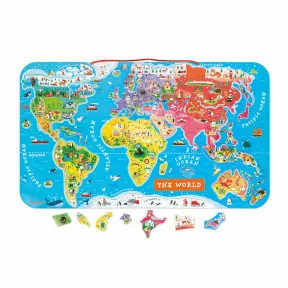
Magnetic World Map Puzzle English Version 92 pieces (wood)
Around the world in 92 magnets! A fun and educational way of discovering the planet. Each magnet represents a country or region of the world, with its name, capital and an illustration characteristic of that part of the world. The big magnetic board shows the world with its continents and oceans : the colour used for each region helps you find its place. Have fun putting each country in its place and you will have a wonderful map of the world which you can hang on the wall.
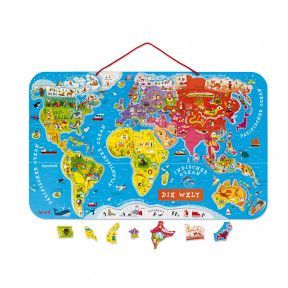
Magnetic World Map Puzzle German Version 92 pieces (wood)
Around the world in 92 magnets ! Each magnet represents a country or region of the world, with its name, capital and an illustration characteristic of that part of the world. The big magnetic board shows the world with its continents and oceans : the colour used for each region helps you find its place. Have fun putting each country in its place and you will have a wonderful map of the world which you can hang on the wall. A fun and educational way of discovering the planet. Around the world in 92 magnets!
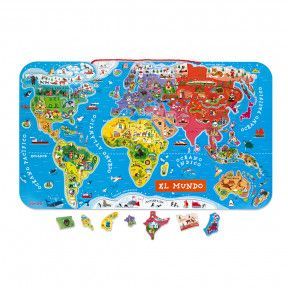
Magnetic World Map Puzzle Spanish Version 92 pieces (wood)
Magnetic World map puzzle - Spanish version. 92 wooden magnetic pieces to assemble. Learn and visit all the countries around the word. An fun and efficiant method to learn the world geography.
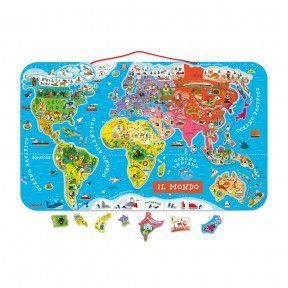
Magnetic World Map Puzzle Italian Version 92 pieces (wood)
Magnetic World map puzzle - Italian version. 92 wooden magnetic pieces to assemble. Learn and visit all the countries around the word. An fun and efficiant method to learn the world geography.
With a magnetic France puzzle, you can travel the length and breadth of France without leaving home! The 93 magnetic pieces of this map of France puzzle invite you to discover the departments and regions on any magnetic surface: let's go on a tour of France! And if you want to go even further, Europe is waiting for you with a magnetic Europe puzzle. You can even discover Italy, Spain or Germany with a puzzle: learning geography is even more fun with magnets!

Magnetic France Map 93 pieces - French (wood) - In French Only
How about an easy and fun tour of France with this beautiful magnetic map with colourful and lively illustrations! This educational puzzle of the French departments is a must-have map of France for 7 to 12 year olds! They will enjoy discovering the 13 French regions, through the 93 magnets to be placed in the right place on the map. The little ones will become geography experts! Each magnet shows the number and name of the department, the capital and a drawing of a local speciality. The magnetic board shows the regions, major rivers, mountain ranges, seas, oceans, overseas departments and border countries. So you can travel without leaving your house and see where your grandparents live! The puzzle is made of wood and can be fixed to the wall thanks to the integrated red cord.
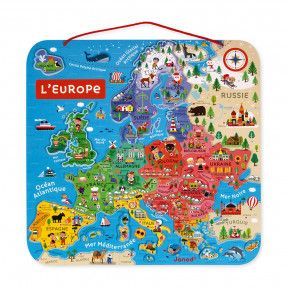
Magnetic European Map in French - In French Only
Let's go around Europe in 40 magnets! This magnetic map of Europe allows children from 7 years old to understand the world around them on a larger scale. For older children, they can learn and revise their geography lessons while having fun! This map reproduces the European continent, the different countries, seas and oceans. Each magnet represents a country or a region of the world with its name, its capital and an illustration explaining its specialities. Children will have fun putting each country in its place. The 4 different colours of magnets help them to locate Central, Southern, Northern and Eastern Europe. This map is a fun and educational way to discover a small part of the world and to visualise their future travels through Europe! In addition, it is easy to hang on the wall above a desk for example!
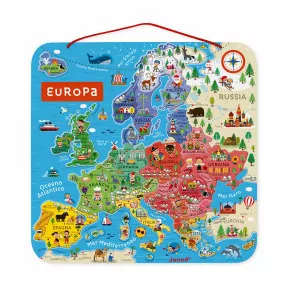
Magnetic European Map in Italian
Have fun learning geography! Each magnet represents a country or region of the world, with its name, capital city and an illustration characterising that part of the world. The large magnetic board displays Europe and its various countries, seas and oceans. Have fun putting each country in the right place. When you have finished, you will have a fantastic map of Europe in italian that you can hang on the wall. It’s a fun and educational way of discovering a little corner of the planet. Take a tour of Europe in 40 magnets! Wooden puzzle (MDF and plywood) and glued printed paper. Comes shrink-wrapped with front sticker and label on the back.
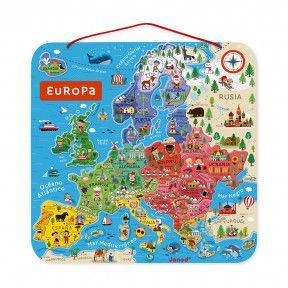
Magnetic European Map Spanish Version
Have fun learning geography! Each magnet represents a country or region of the world, with its name, capital city and an illustration characterising that part of the world. The large magnetic board displays Europe and its various countries, seas and oceans. Have fun putting each country in the right place. When you have finished, you will have a fantastic map of Europe in spanish that you can hang on the wall. It’s a fun and educational way of discovering a little corner of the planet. Take a tour of Europe in 40 magnets! Wooden puzzle (MDF and plywood) and glued printed paper. Comes shrink-wrapped with front sticker and label on the back.
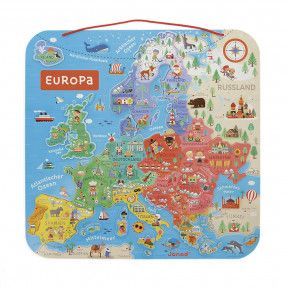
Magnetic European Map German Version
Have fun learning geography! Each magnet represents a country or region of the world, with its name, capital city and an illustration characterising that part of the world. The large magnetic board displays Europe and its various countries, seas and oceans. Have fun putting each country in the right place. When you have finished, you will have a fantastic map of Europe in German that you can hang on the wall. It’s a fun and educational way of discovering a little corner of the planet. Take a tour of Europe in 40 magnets! Wooden puzzle (MDF and plywood) and glued printed paper. Comes shrink-wrapped with front sticker and label on the back.
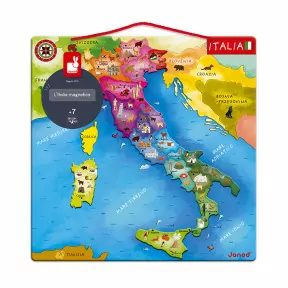
Magnetic Italia Map 20 pieces (wood)
A fun and educational way of discovering Italy. Match the magnets with the same colour and you will discover the different regions with their main cities. On each magnet you will find an icon that is linked with the local area. The magnetic board shows the geography of the country with the principal mountains, rivers and lakes. Contains 50 magnets. Language : Italian.
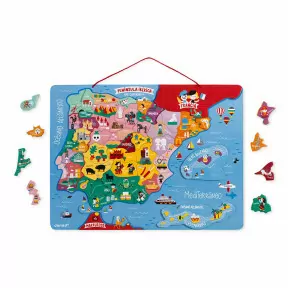
Magnetic Iberian Peninsula Map 50 pieces (wood)
A fun and educational way of discovering Spain. Match the magnets with the same colour and you will discover the different regions with their main cities. On each magnet you will find an icon that is linked with the local area. The magnetic board shows the geography of the country with the principal mountains, rivers and lakes. Contains 50 magnets. Language : Spanish.
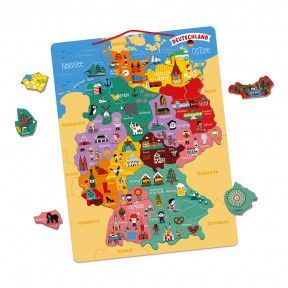
Magnetic German Map 79 pcs (wood)
Learn geography while having fun! The magnets feature the regions (Länder) with illustrations of local specialties and well-known monuments. The Länder are grouped by colour. On the magnetic board are the same Länder, seas, oceans, islands and border countries. Have fun positioning the magnets in the right place, to make a beautiful map of Germany that you can hang on the wall! 79 magnets included. Language : German.
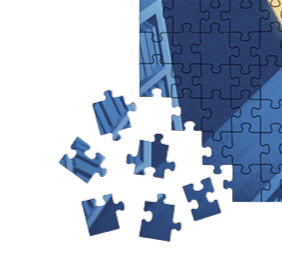
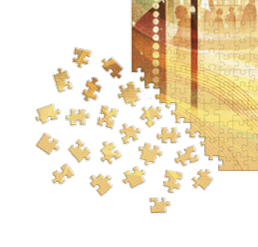
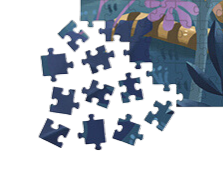
Set-up, organization ... If you want your puzzle activity to remain a fun puzzle and your patience not to be tested, follow our best practices and tips for completing your puzzle!
This should be easy if you've followed our guide's recommendations! Once you've settled on a motif or illustration, there are a few things to bear in mind when choosing a puzzle.
For children, it's a question of considering the age recommended on the box and the simplicity of the model. If the child is experienced, you can offer more complex puzzles with richer illustrations, without necessarily taking into account the age mentioned on the box. At Janod, we're committed to offering a wide variety of puzzles to suit all ages, levels and tastes!
The size of the pieces is also important, as the smaller they are, the more difficult they are to identify and assemble.
The number of pieces is an important criterion: if you're a beginner, choose a puzzle with a maximum of a hundred pieces. The greater the number of pieces, the longer it will take you to complete your puzzle!
Beyond the complexity of the illustrations, the shades of color also play a crucial role in the puzzle's complexity. The more colors there are, the easier it will be to assemble. On the other hand, if all or part of your puzzle is made up of a solid or almost solid color, your patience and logic will be called upon even more!
Now you've got your puzzle: you can't wait to get started, can you? But wait a minute! Before you get started, it's important to anticipate and organize where you're going to set up.
If you don't, you run the risk of being surprised halfway through by a puzzle sticking out of the table, and having to start all over again to assemble it somewhere else! To prevent this from happening, all Janod de puzzle dimensions are listed on each online product sheet.
Make sure your space is not in a high-traffic area or a living room. Bear in mind that it will probably take you several sessions over several days to complete your puzzle, so avoid being interrupted or disturbed by passing pets, for example.
Choose a space or table that is not intended for guests or other activities. This will save you a lot of frustration and guarantee you a calm environment in which to complete your puzzle.
You're about to embark on an activity that will take you several hours to complete. Once you've chosen and organized your space, and to make assembling your puzzle a real moment of relaxation and escape, create your own atmosphere! Relaxing background music to soothe your thoughts, energetic music to keep the pace, or simply your favorite playlist; or, on the contrary, complete calm. A comfortable armchair or chair, your favorite drink, and off you go for a moment that's all your own.
Make sure you don't neglect thelighting, however, and find the right compromise between a relaxing ambience and the brightness you need to complete your puzzle: it's all about seeing the pieces and their features clearly, so you can put them together in the right way.
To avoid panicking when you open your puzzle and to get off to a good start, start by sorting the pieces. One by one, sort the pieces according to 2 criteria:
You can also use small bins to organize the pieces so they don't get lost.
Once you've sorted the pieces, you can easily identify those with edges. Use them to start assembling your puzzle, forming the corners and then the frame, before moving on to the filling. This method saves you a lot of time!
Putting together a puzzle should remain a relaxing and entertaining activity. If you find yourself getting frustrated or stuck, don't hesitate to take a break, leave the puzzle aside and come back to it with clearer ideas. With a new point of view, the location of a piece can quickly become more obvious!
There's no need to set yourself a time target for completing your puzzle. Completing it is a challenge in itself, so there's no need to stress out if you don't finish your puzzle in a given time! It's always nice to take an hour for yourself, and relaxing over a puzzle is an even more beneficial occupation!
Puzzle-making is a time-consuming activity, ideal for occupying your time in a playful way. But time can go by very quickly and, captivated by your puzzle, you may be surprised to find that you've put aside certain obligations! Make sure you don't get bogged down in the puzzle-making process, taking regular breaks and spreading the work out over several days if necessary.
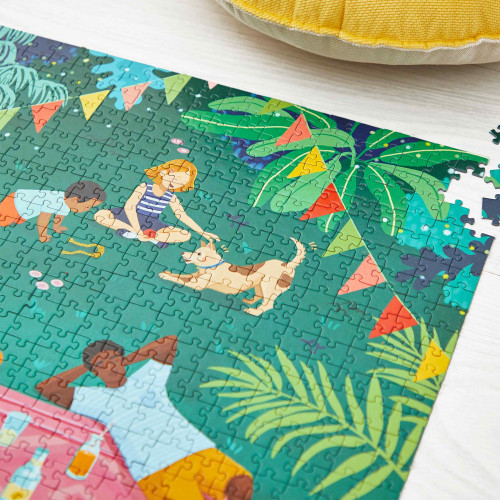
As well as being an activity that children love, puzzles enable them to acquire many skills that are essential for their development. For adults and children alike, puzzles have positive effects on our brain and cognitive functions:
Anaïs CLERC and Gaëlle BLERVAQUE are state-qualified psychomotricians. They explain the benefits of puzzles for children's development, and give advice on how to use puzzles in the family:
"When you give a puzzle to a child, or an adult for that matter (and yes, there's no age limit), you're contributing to the development of their visuo-spatial skills.
This skill area is defined as the neurological process of visually analyzing, integrating and reproducing the spatial characteristics of an element or ensemble in a given space. These skills are called upon at all times in our daily lives. We need them when we're learning to write and read (recognizing the shape of letters, numbers and words), when we're putting down an operation in mathematics, when we're learning traffic signs, or when we're finding our way around a map or chart.
An activity like putting together a puzzle doesn't require graphic skills, however, the child must be able to identify the shape of each piece." Read more
